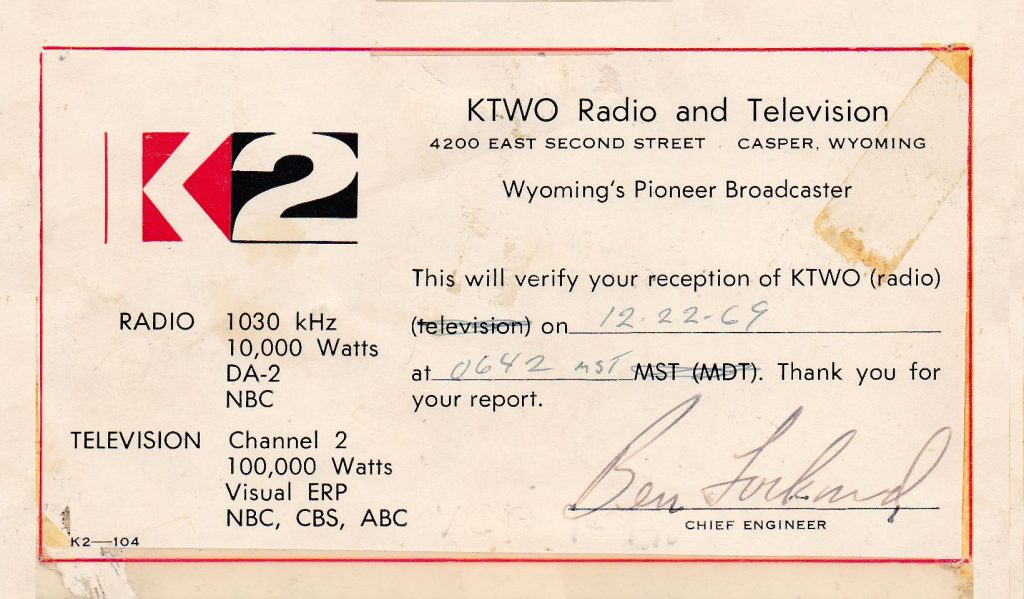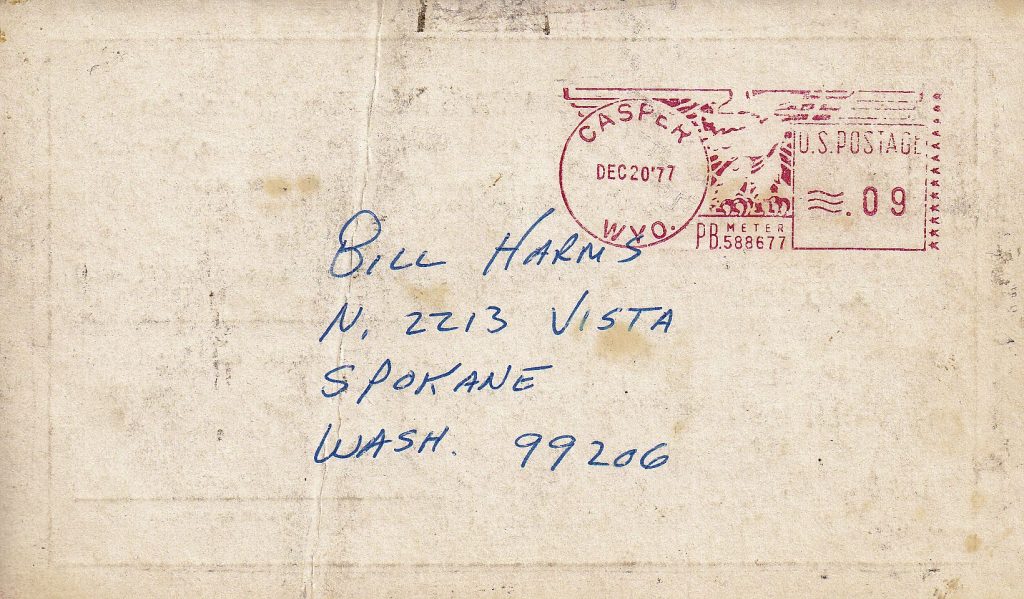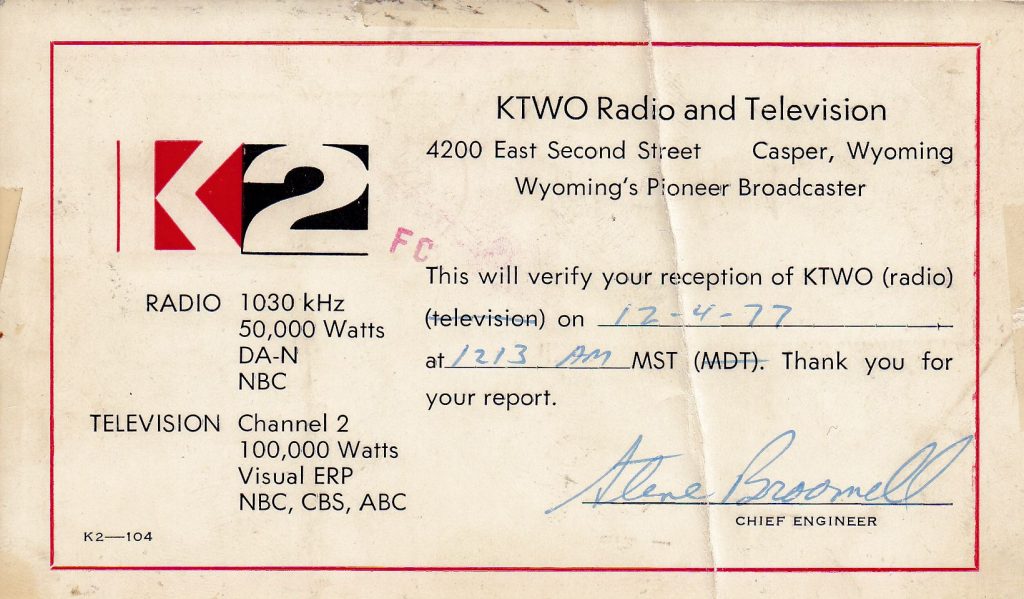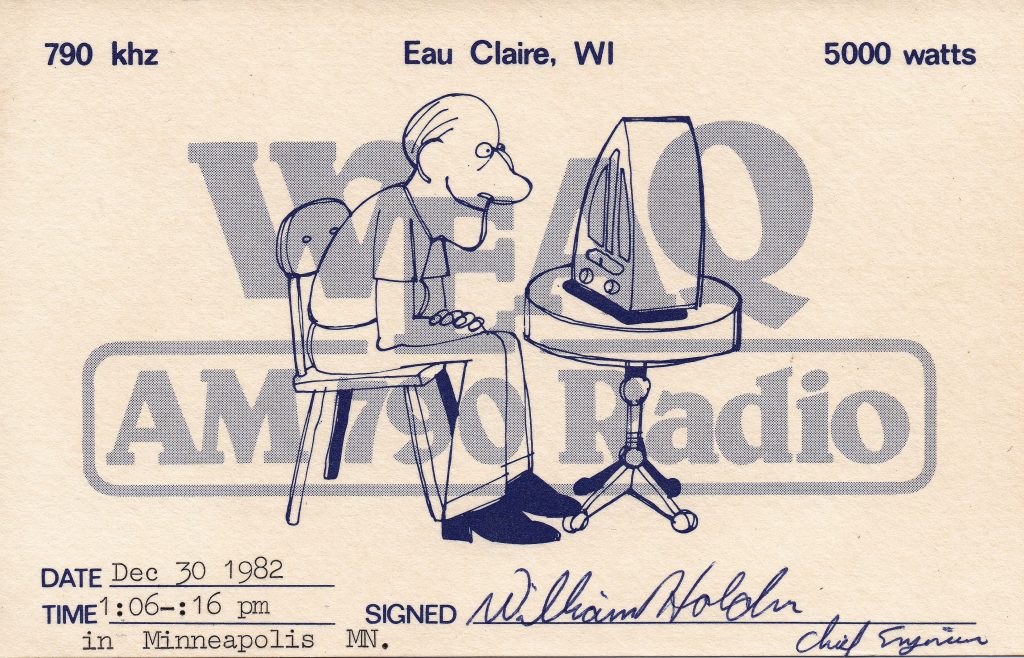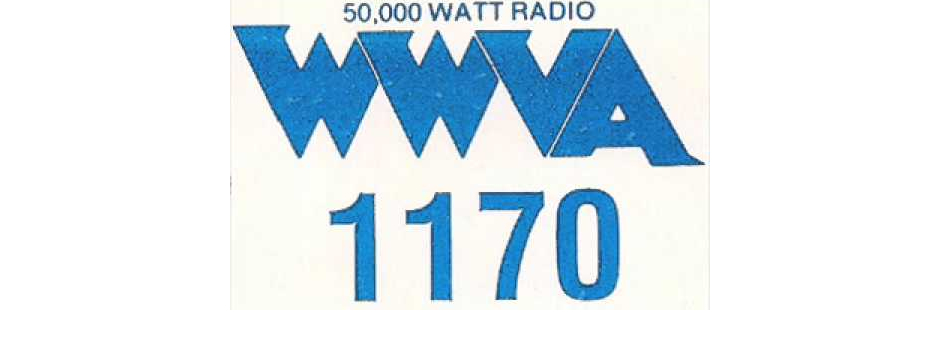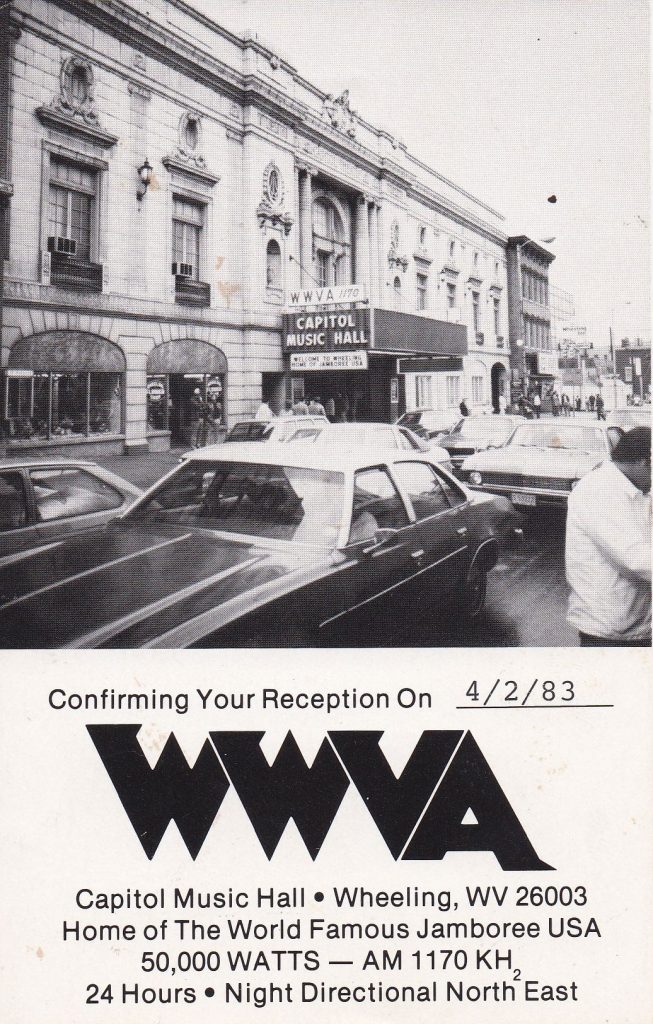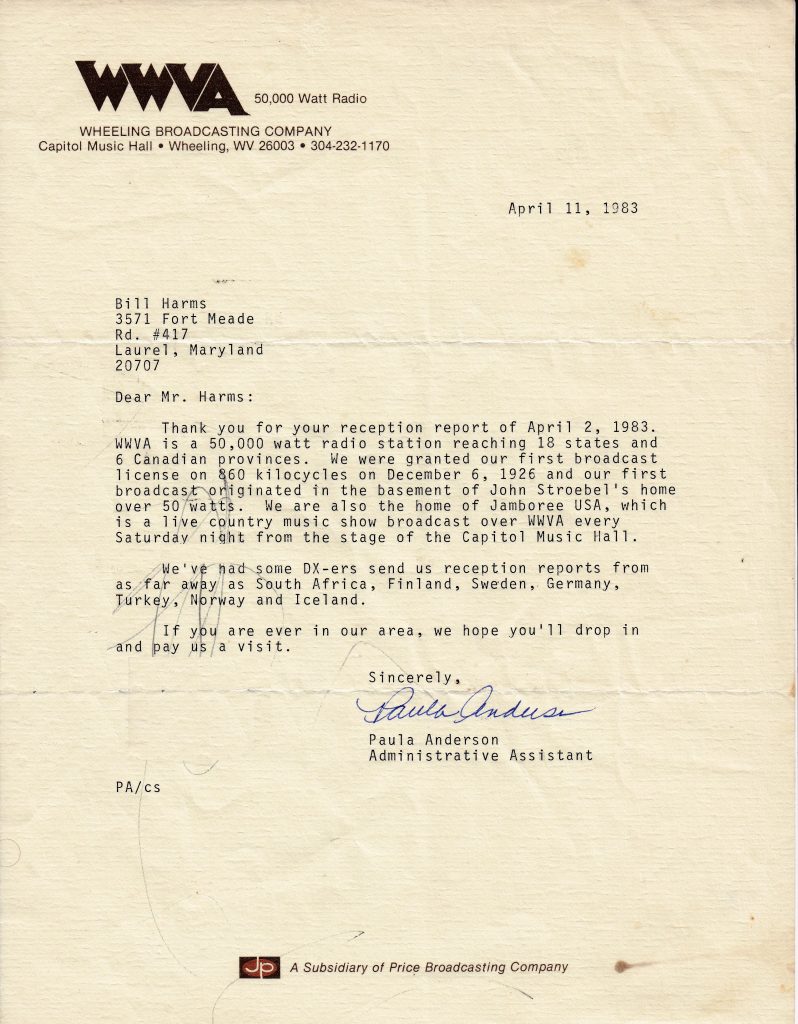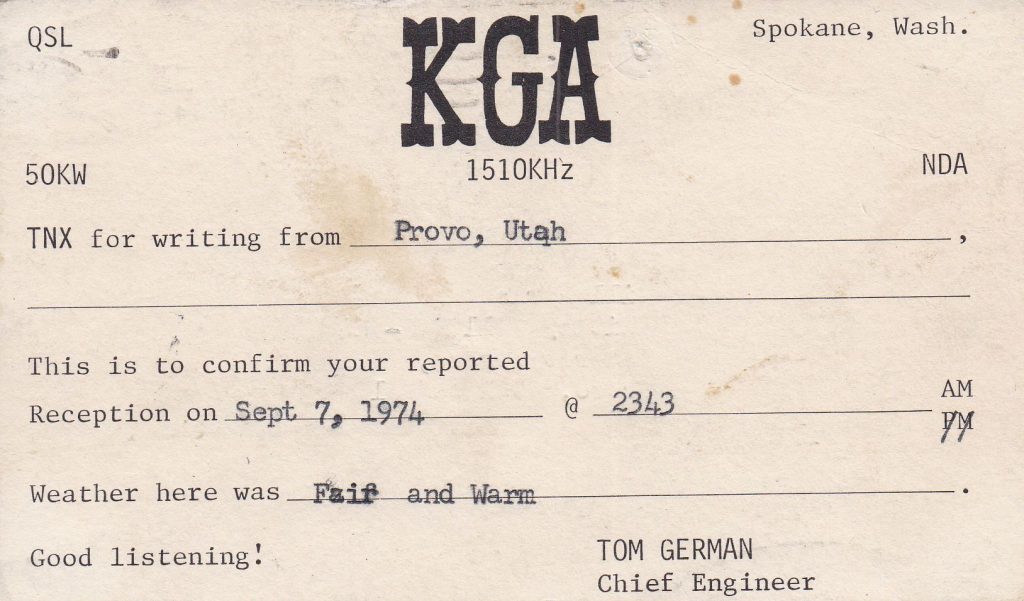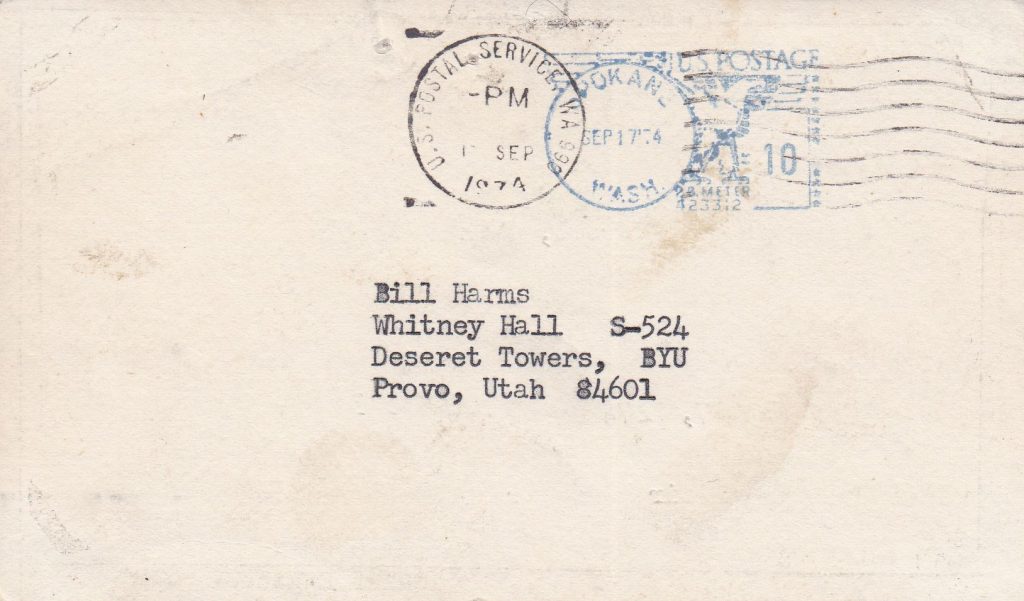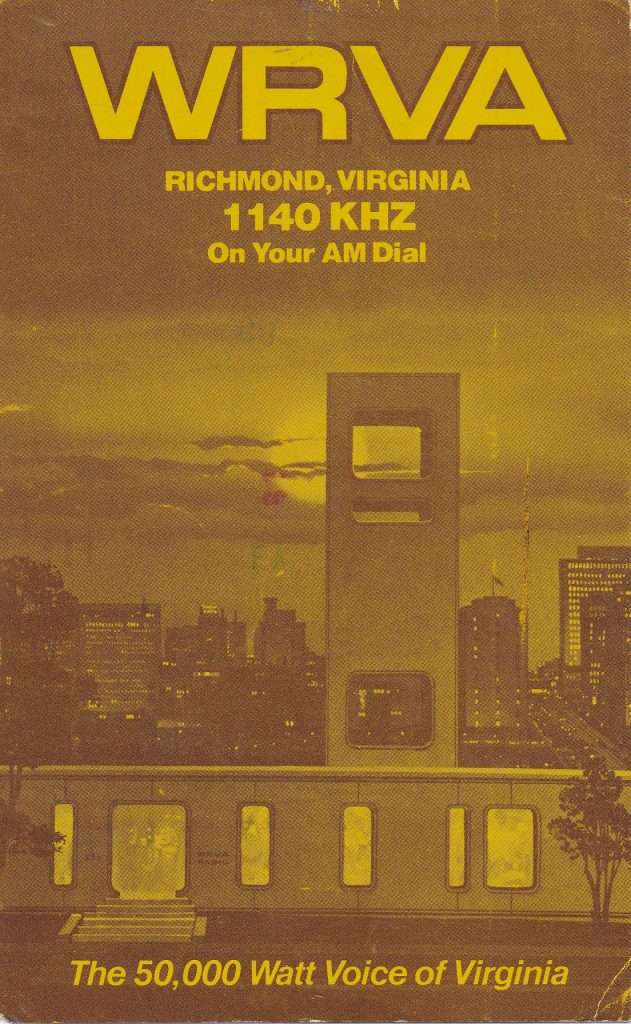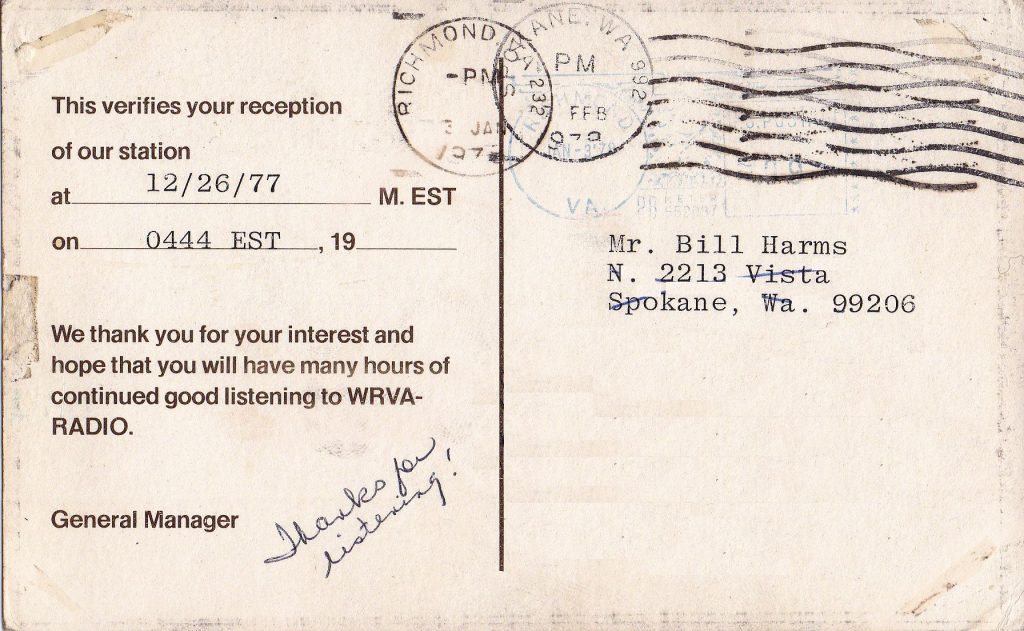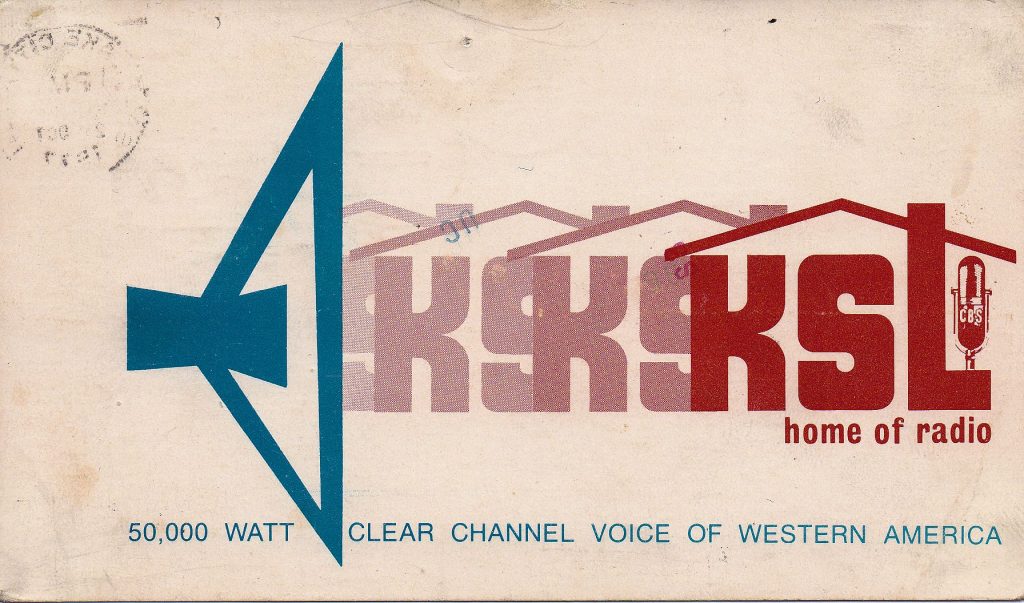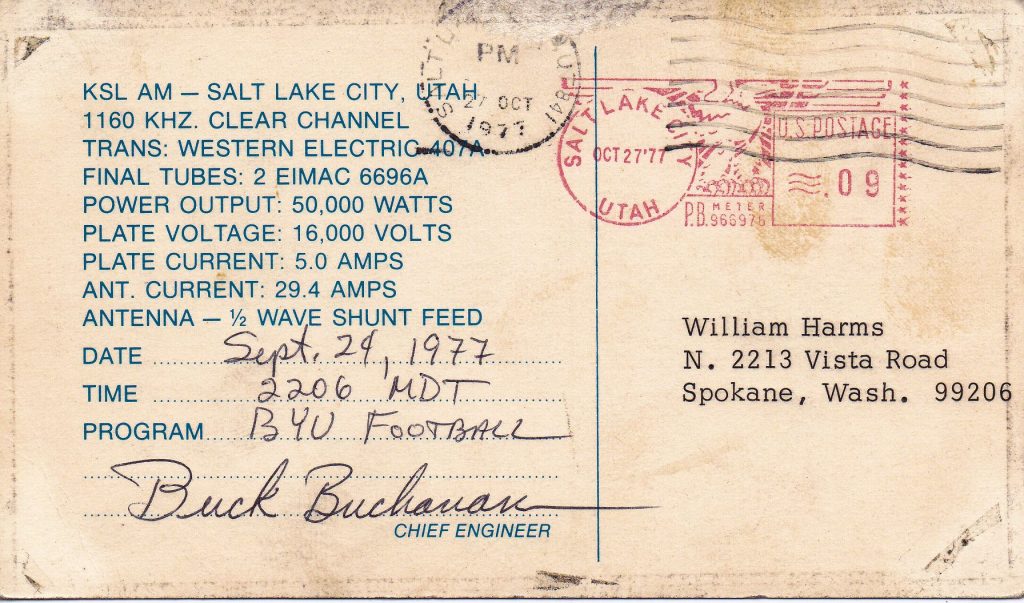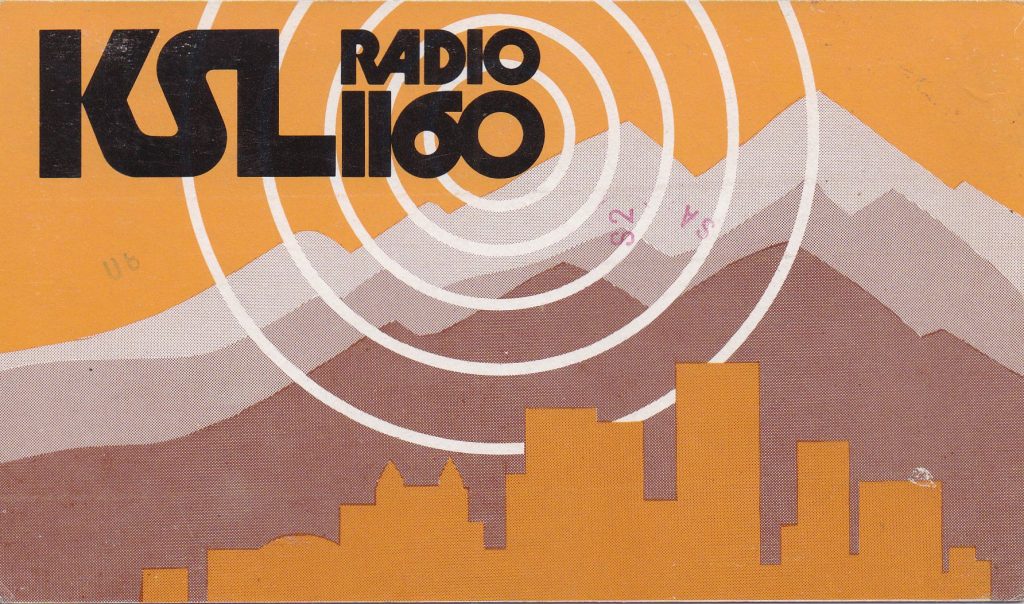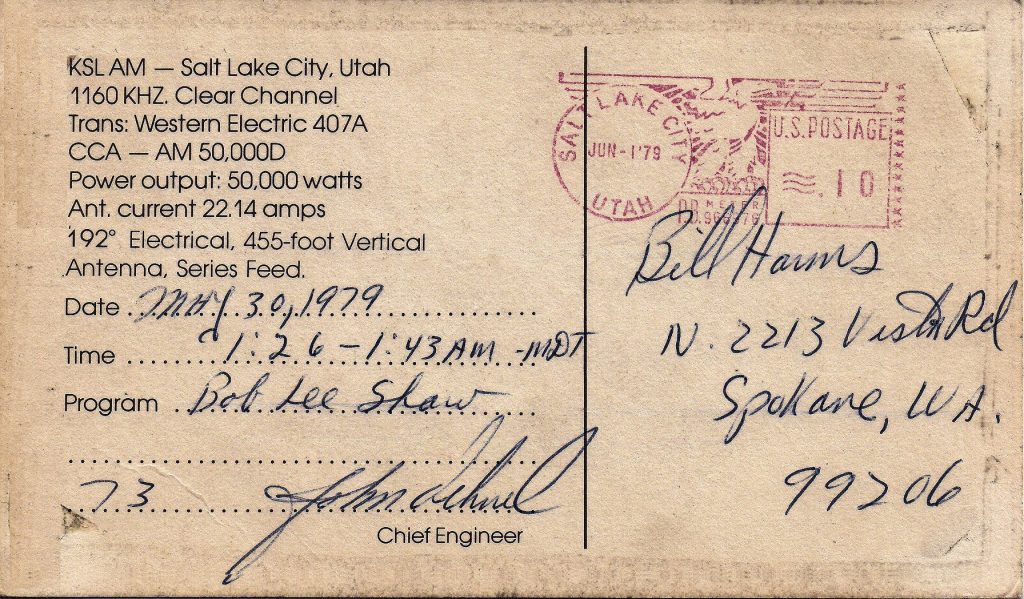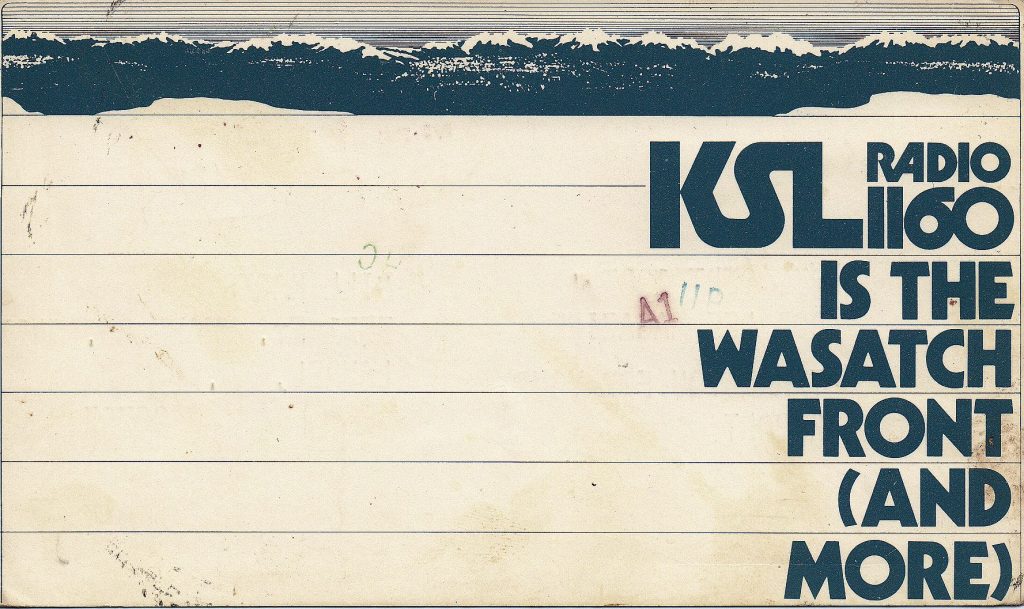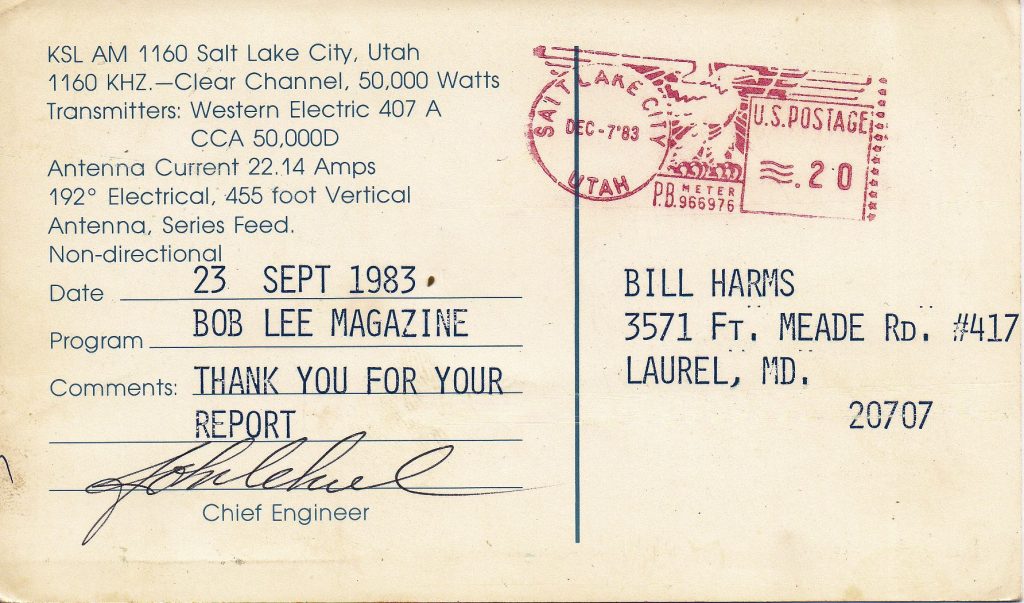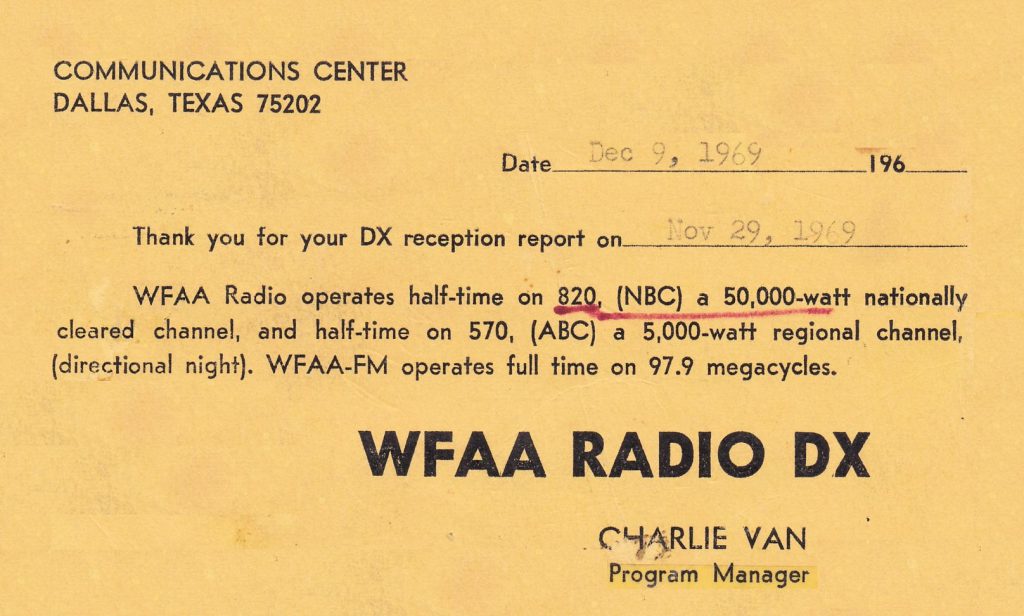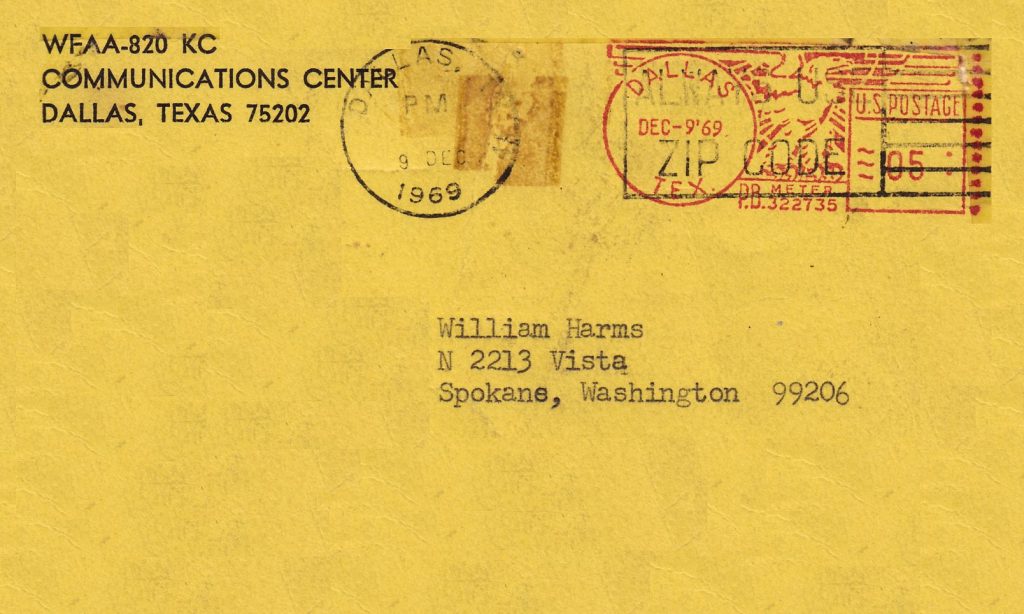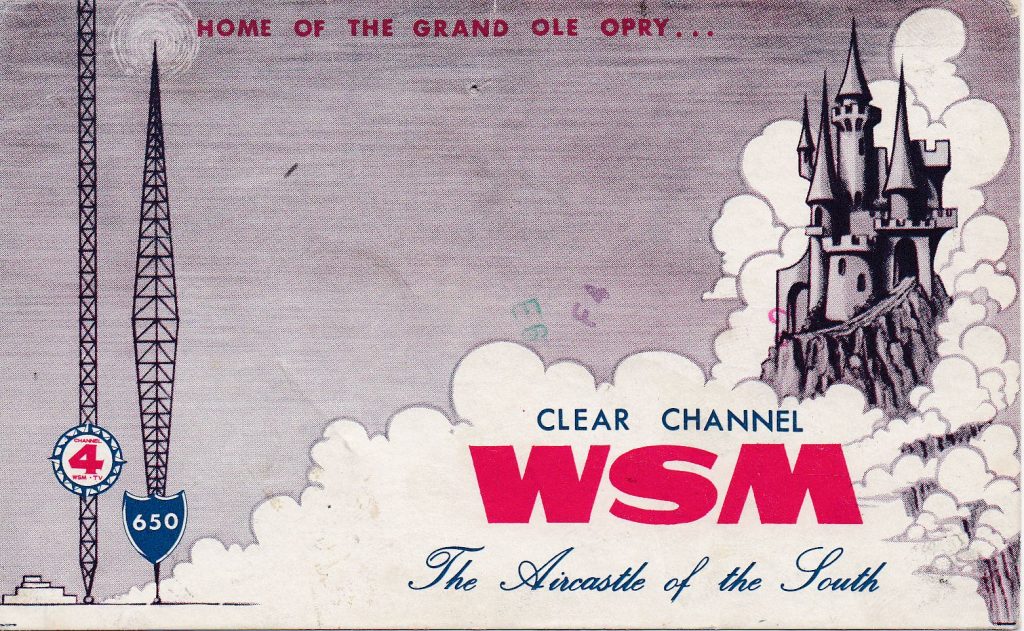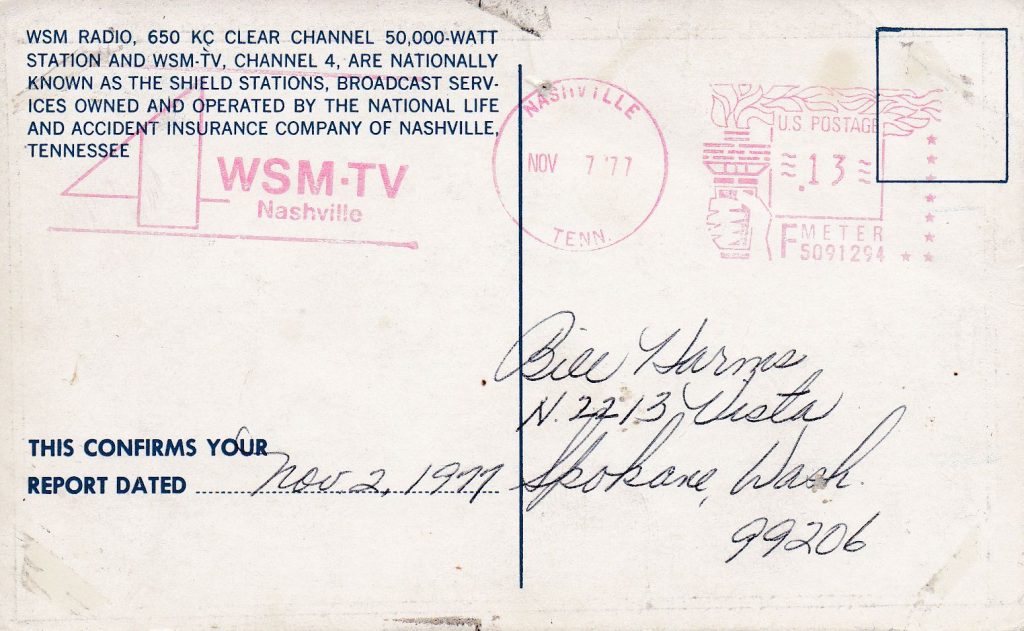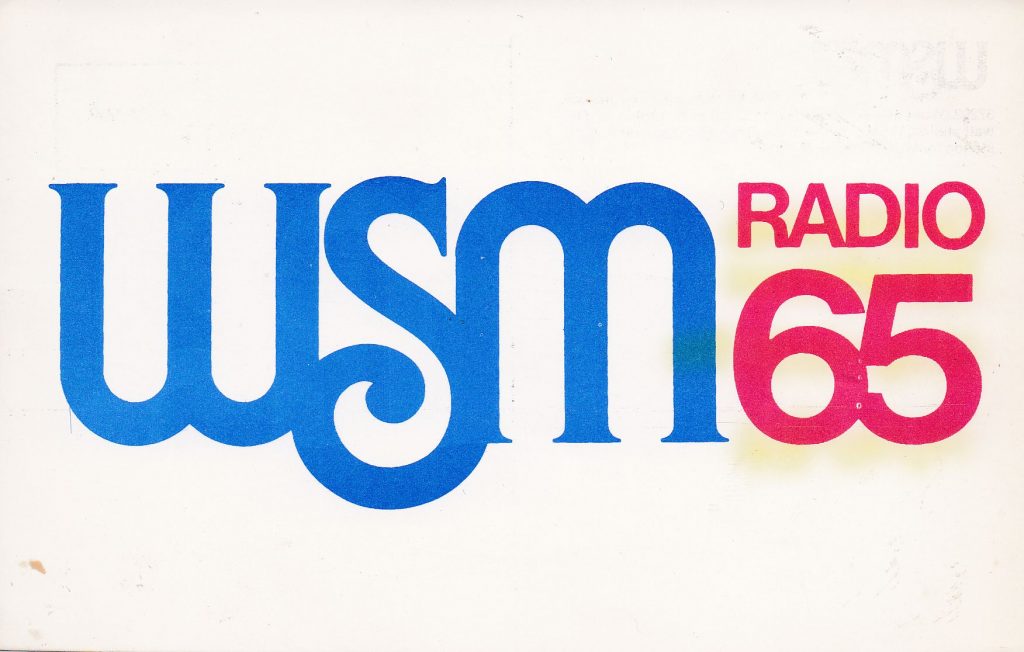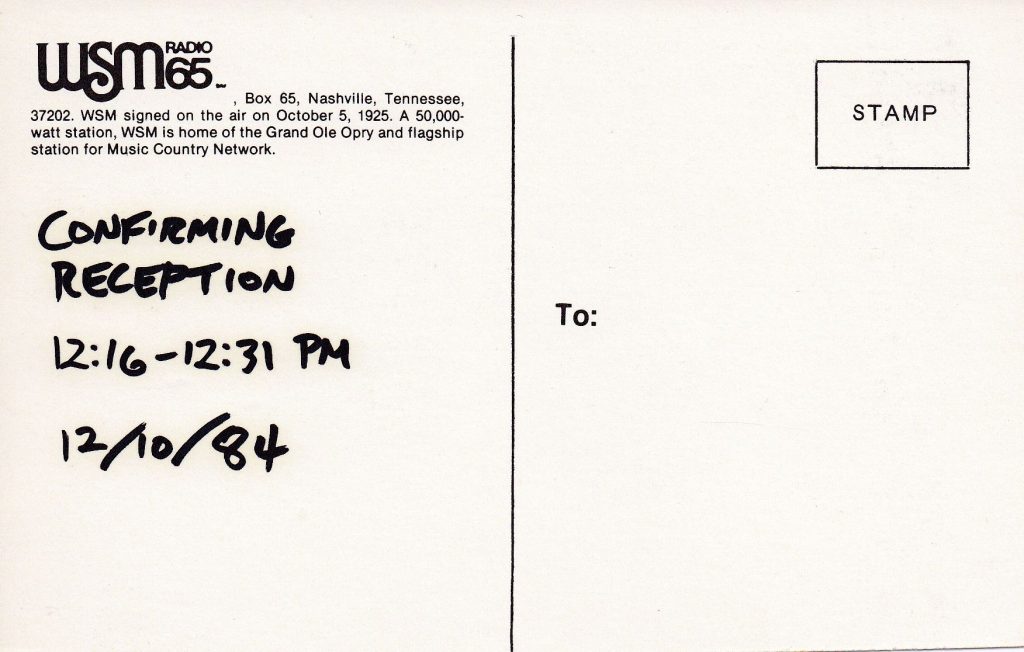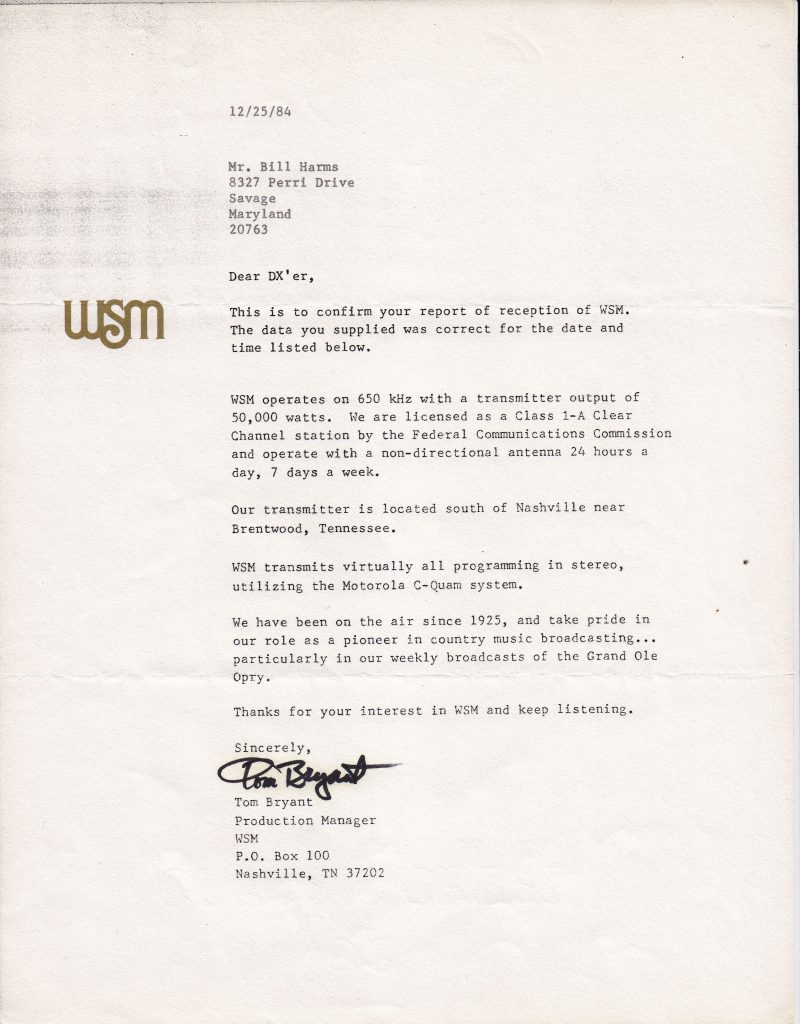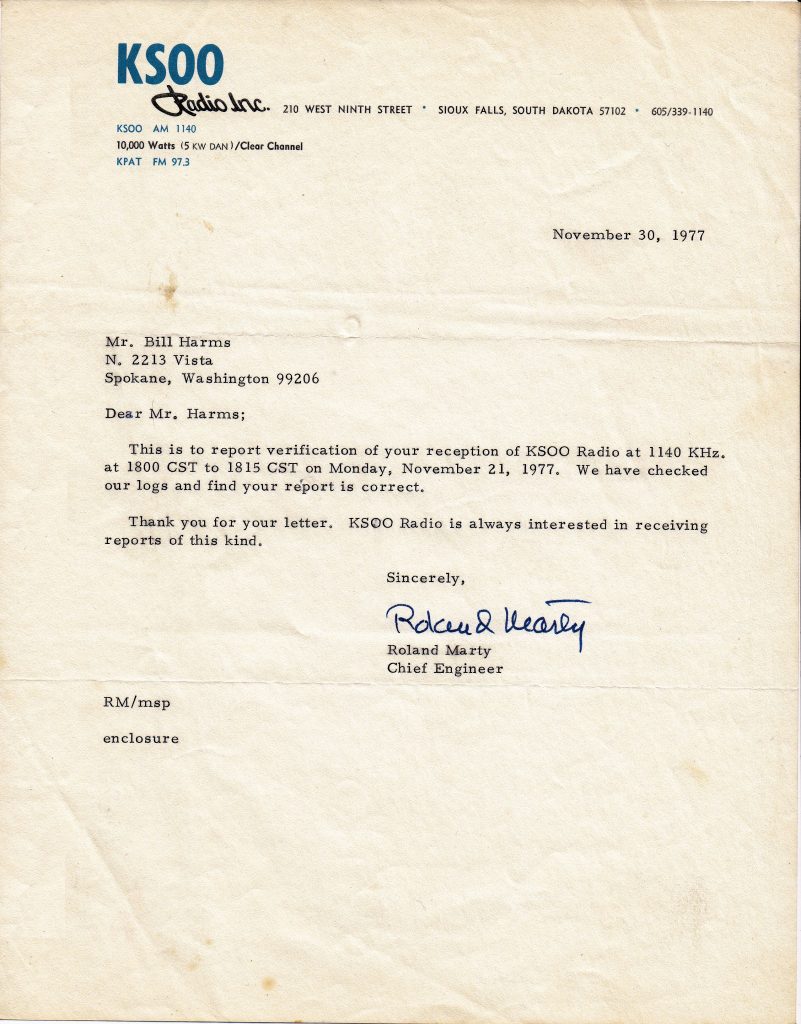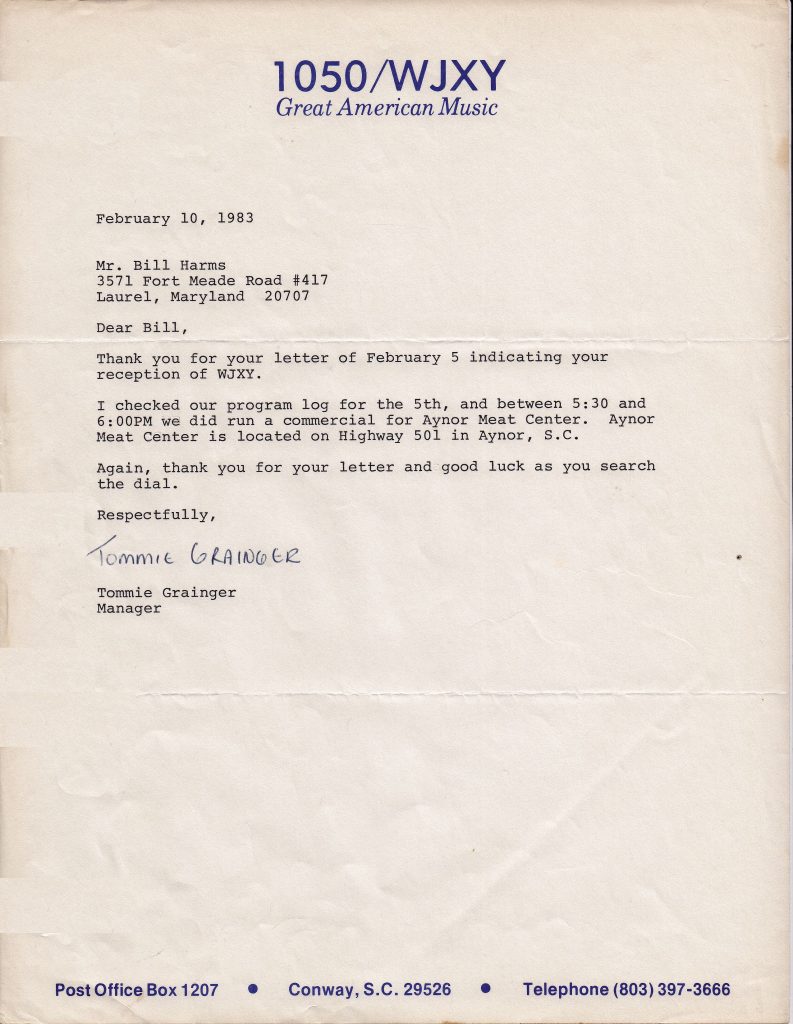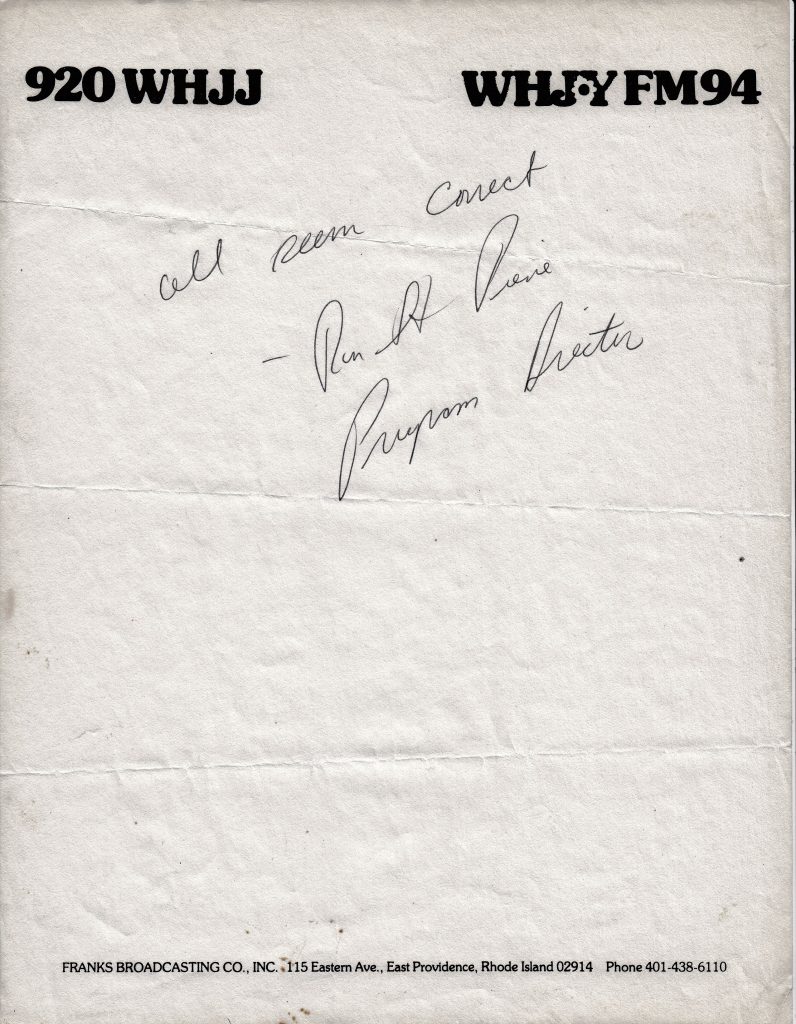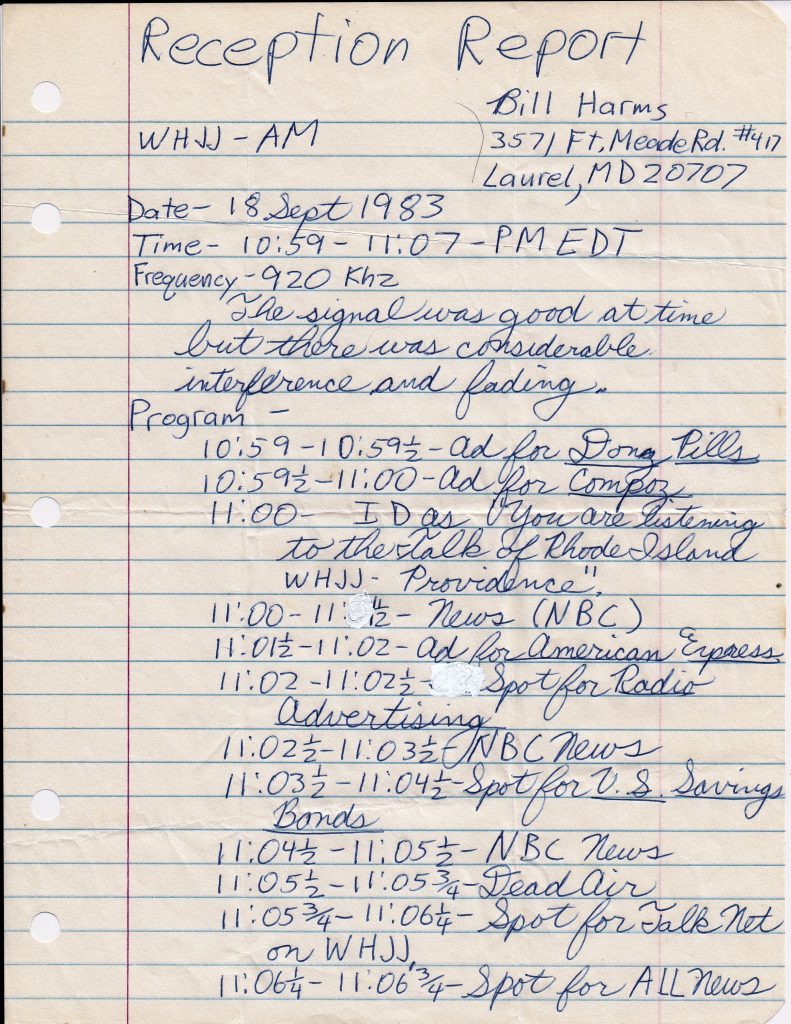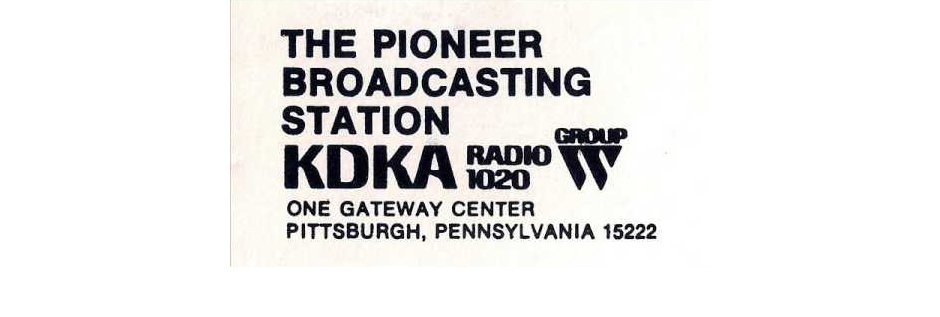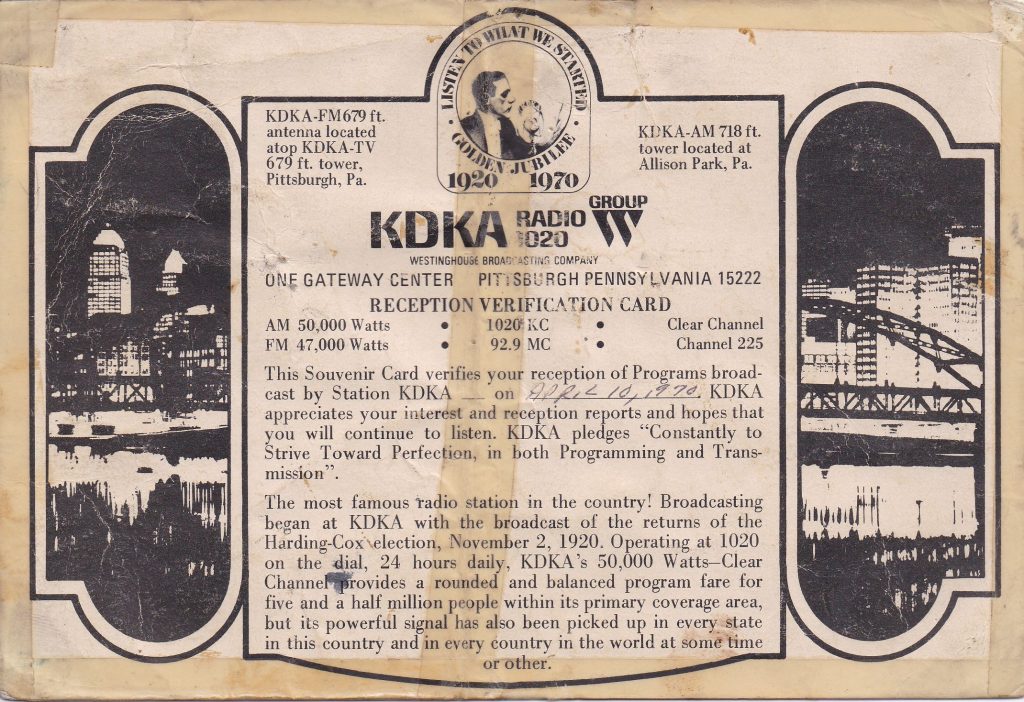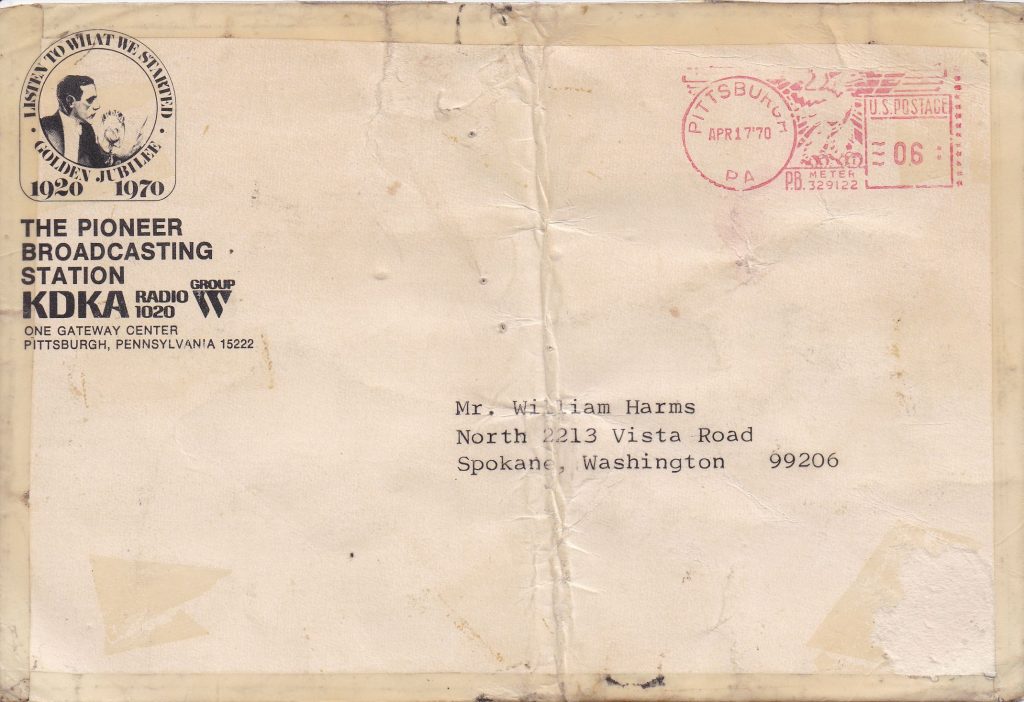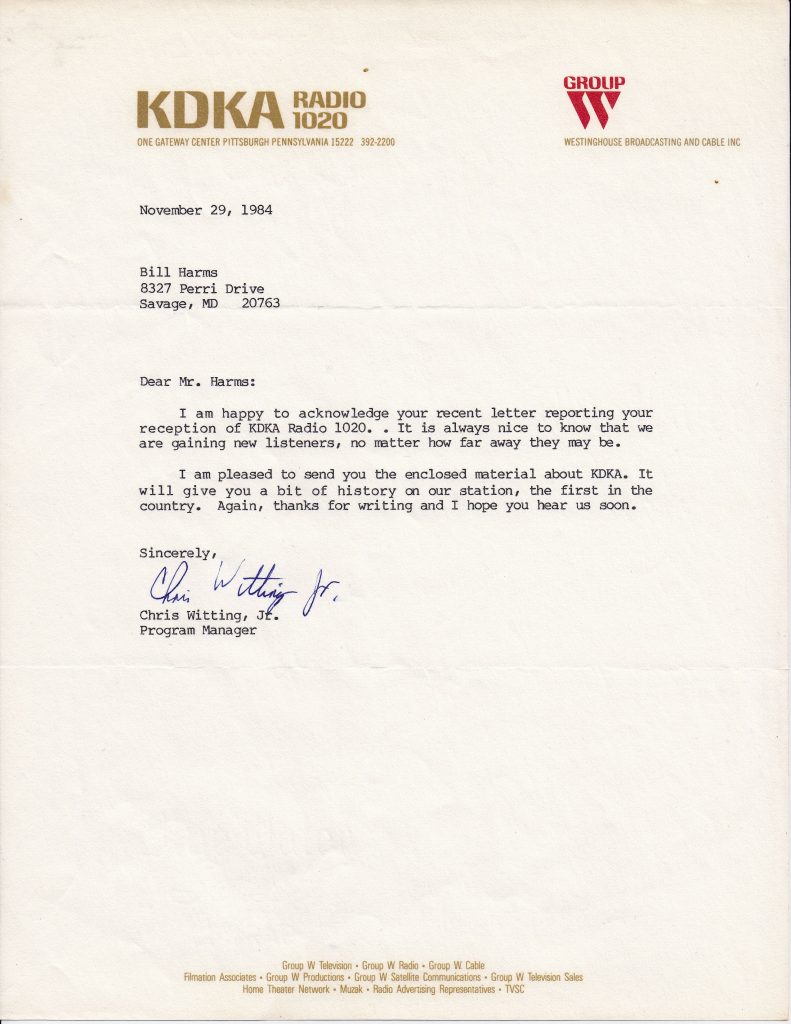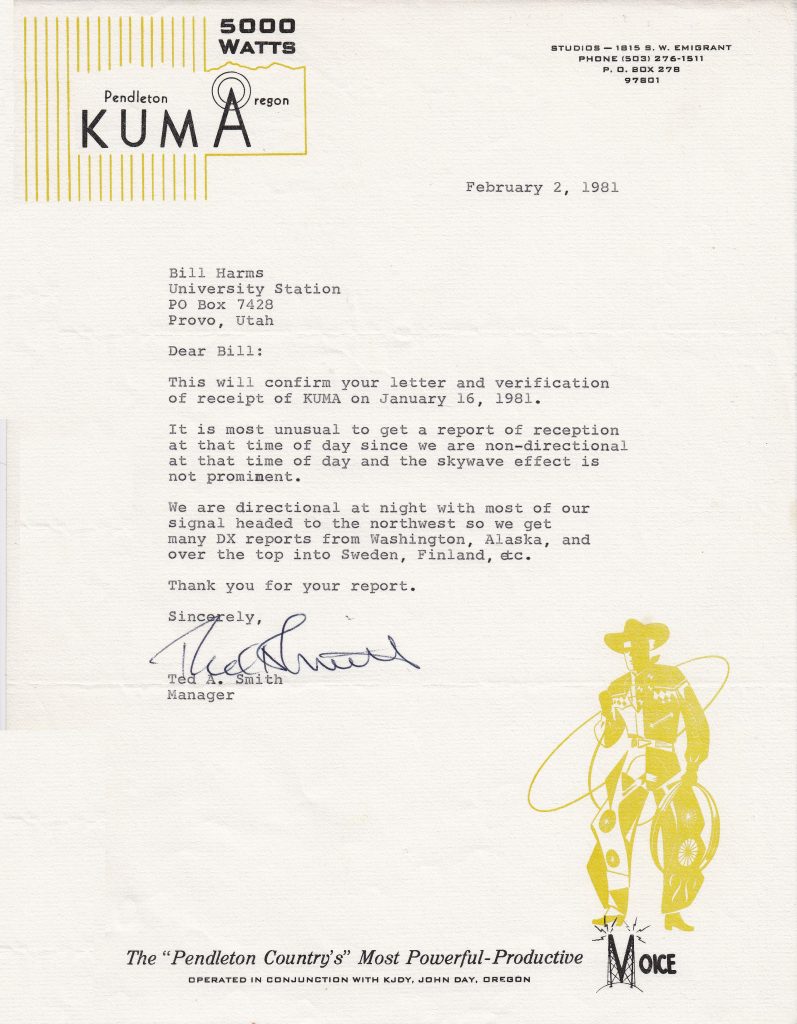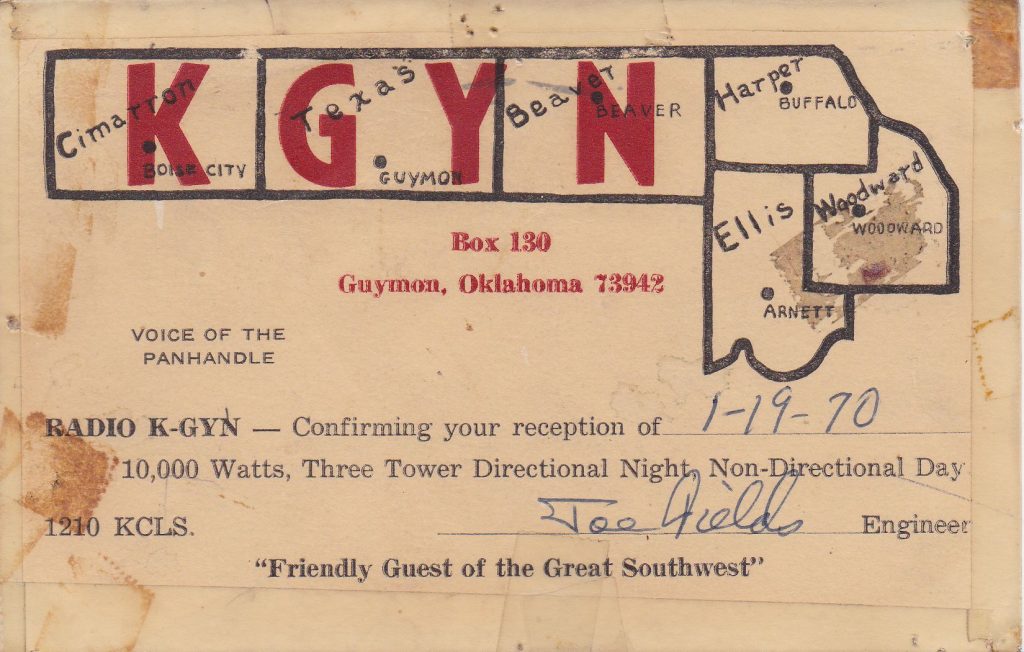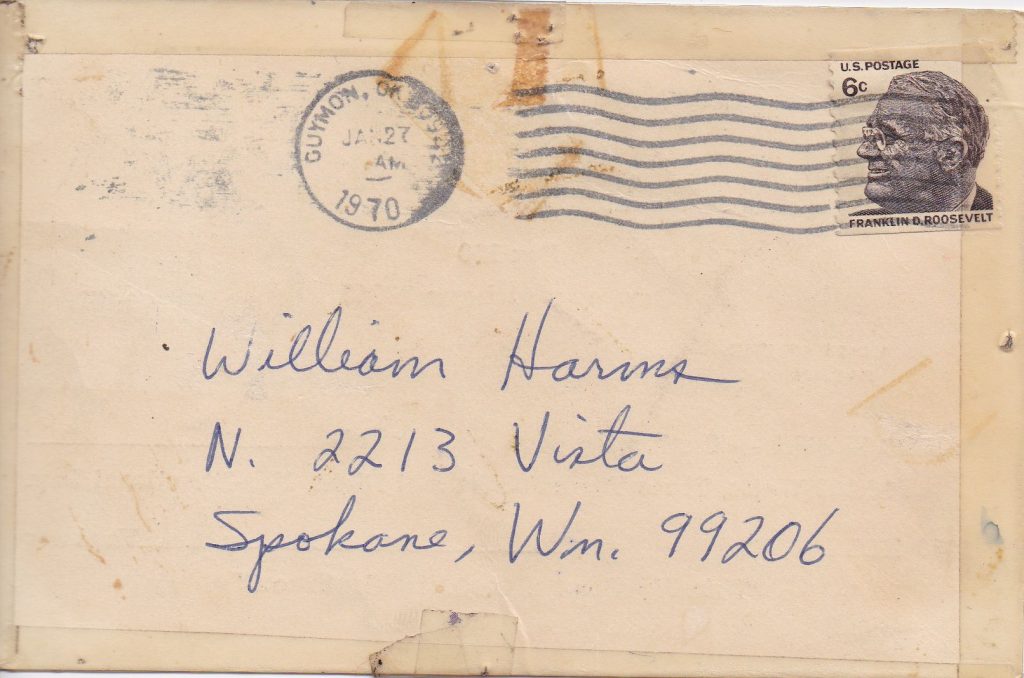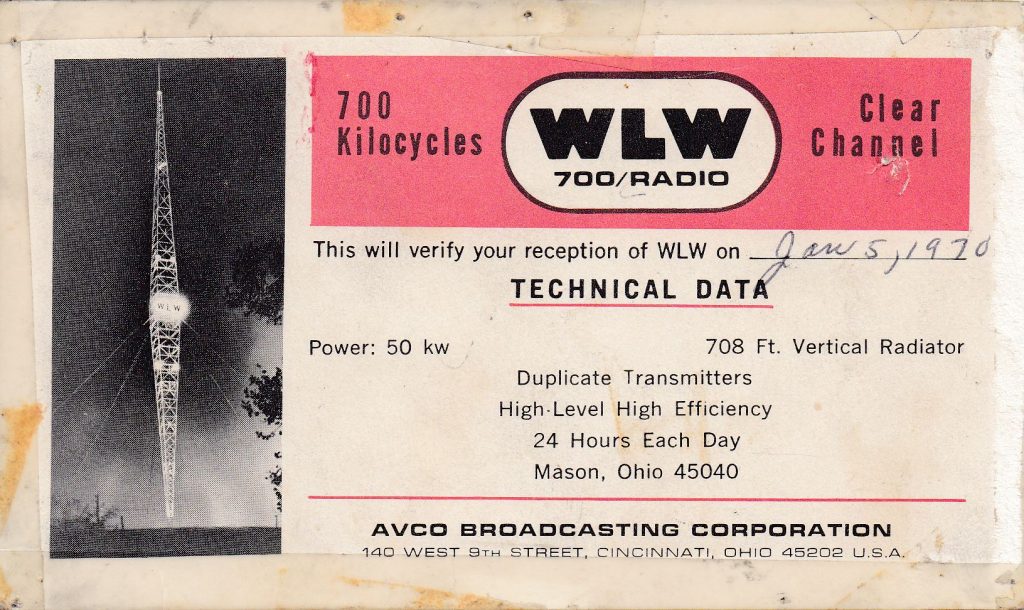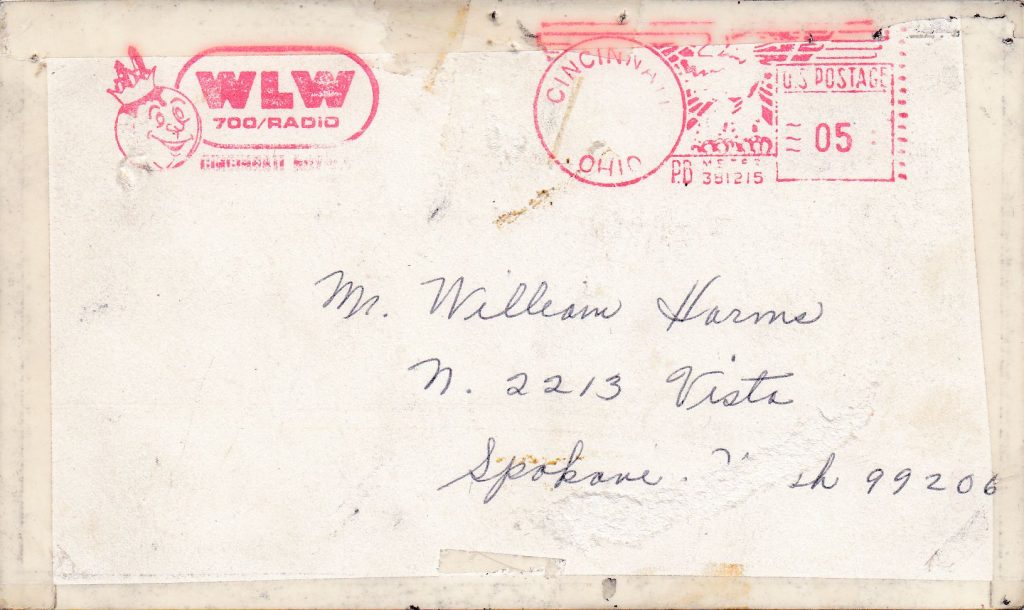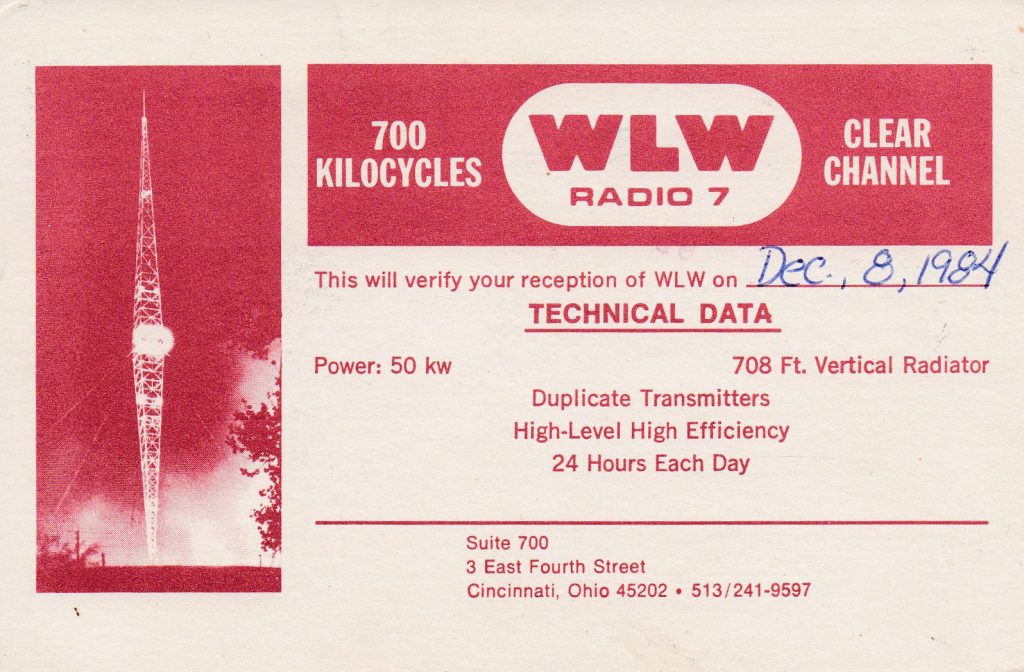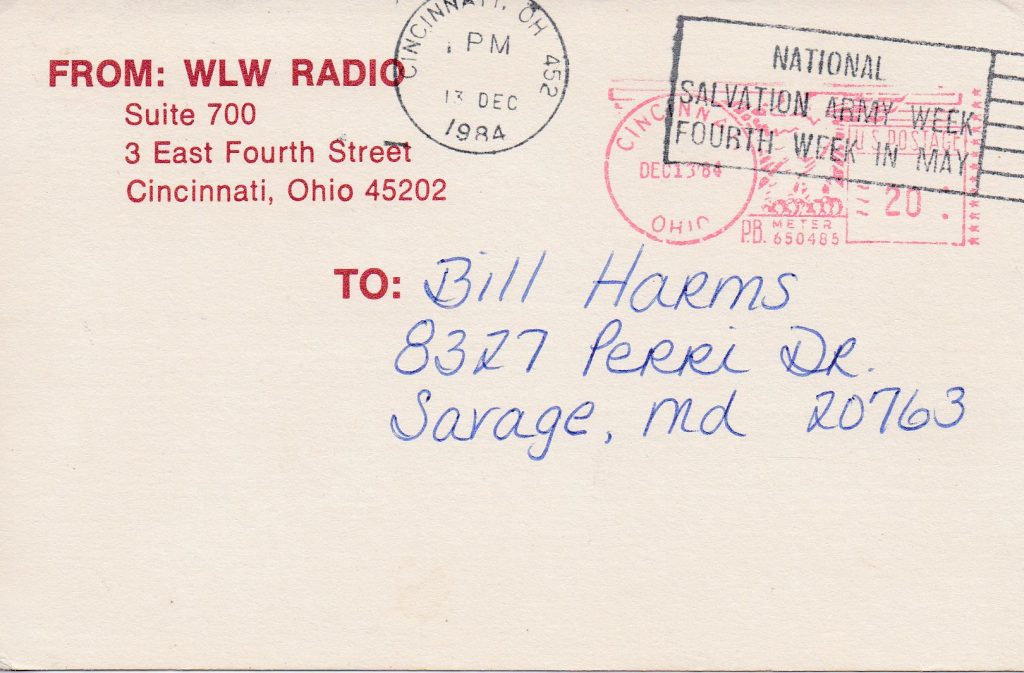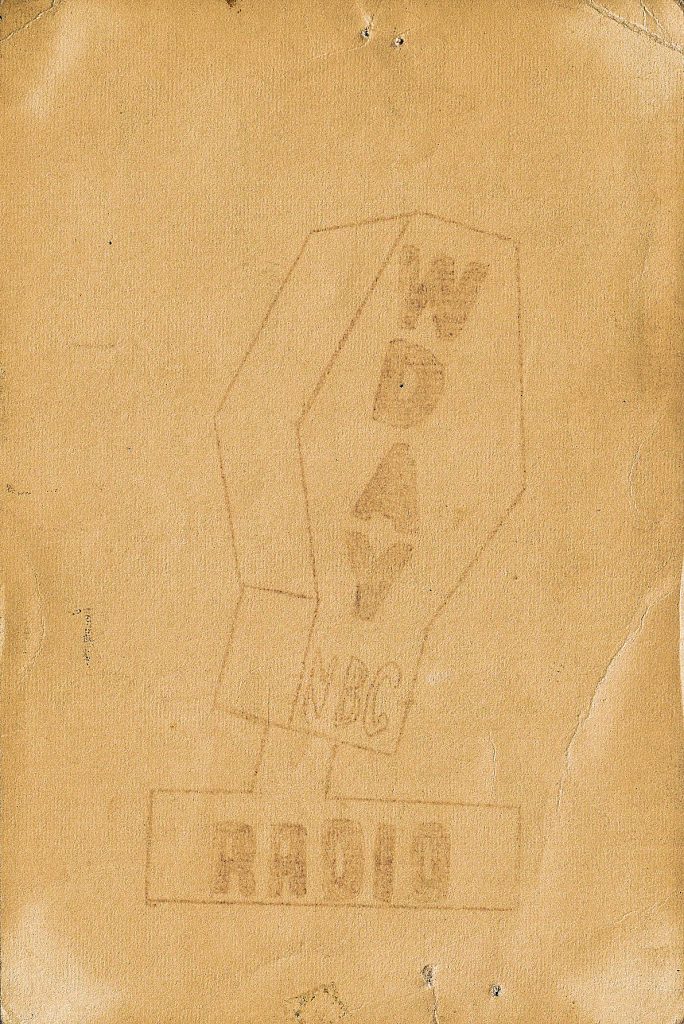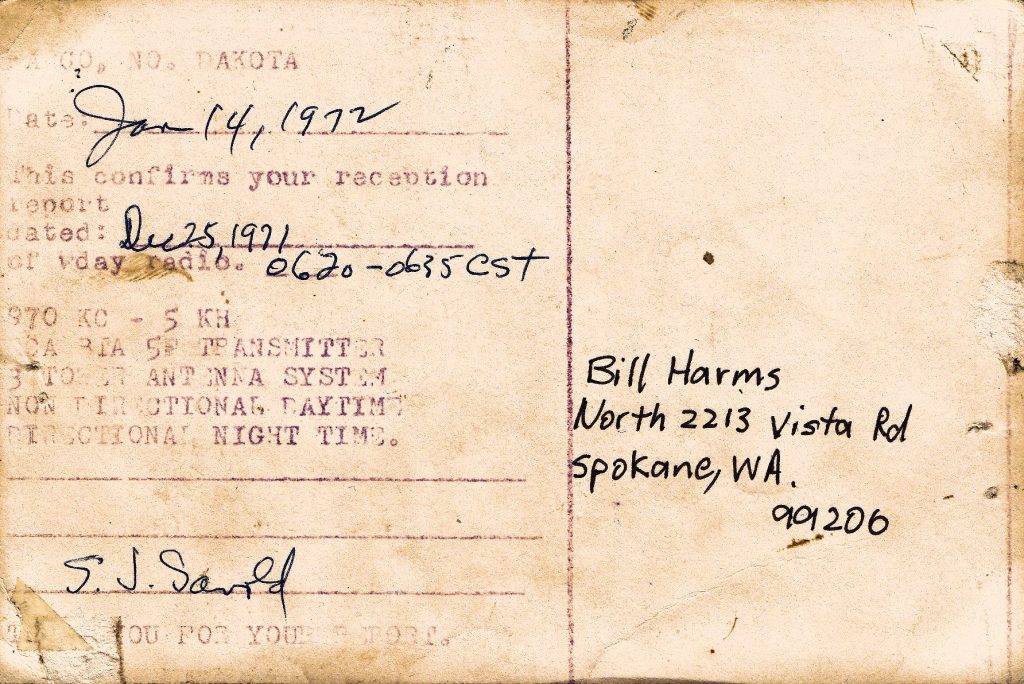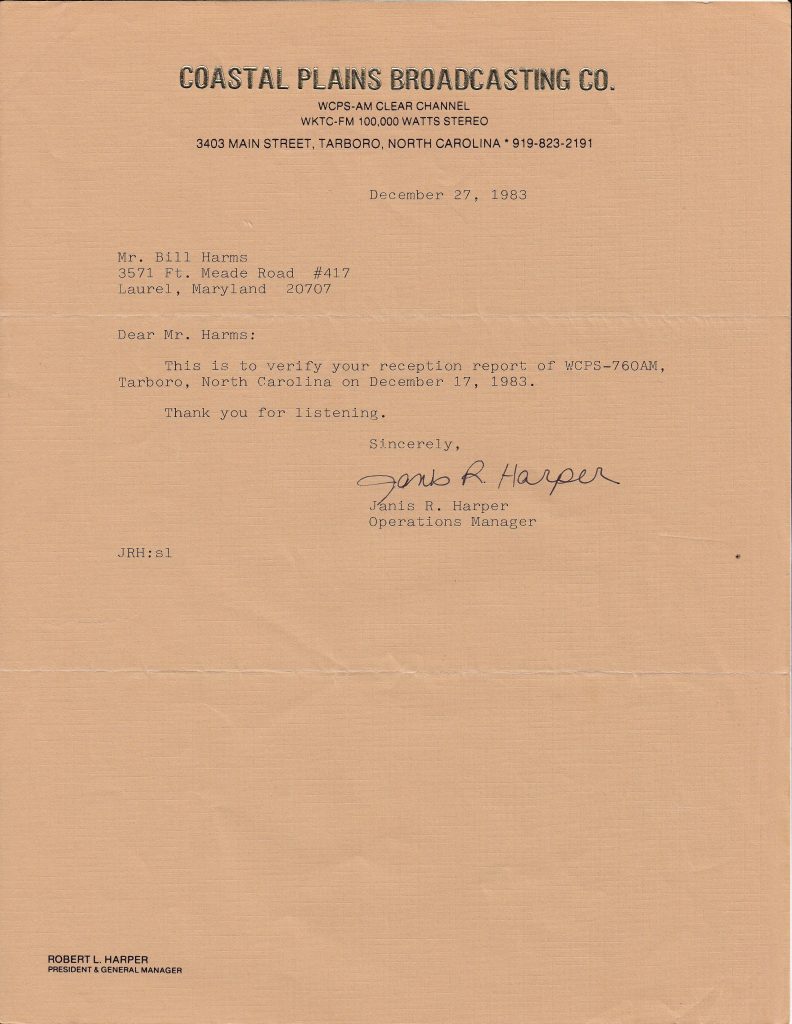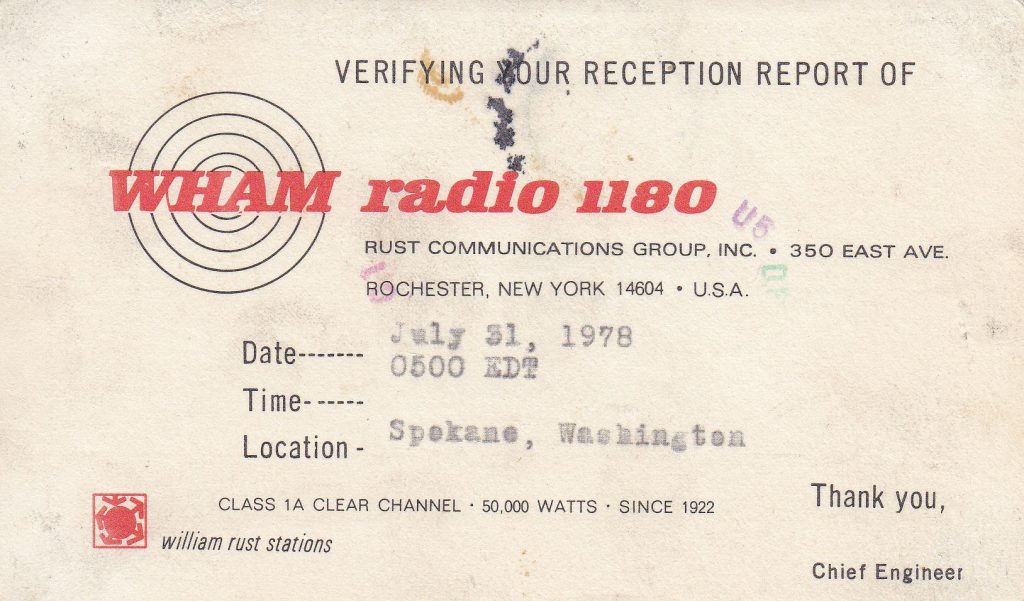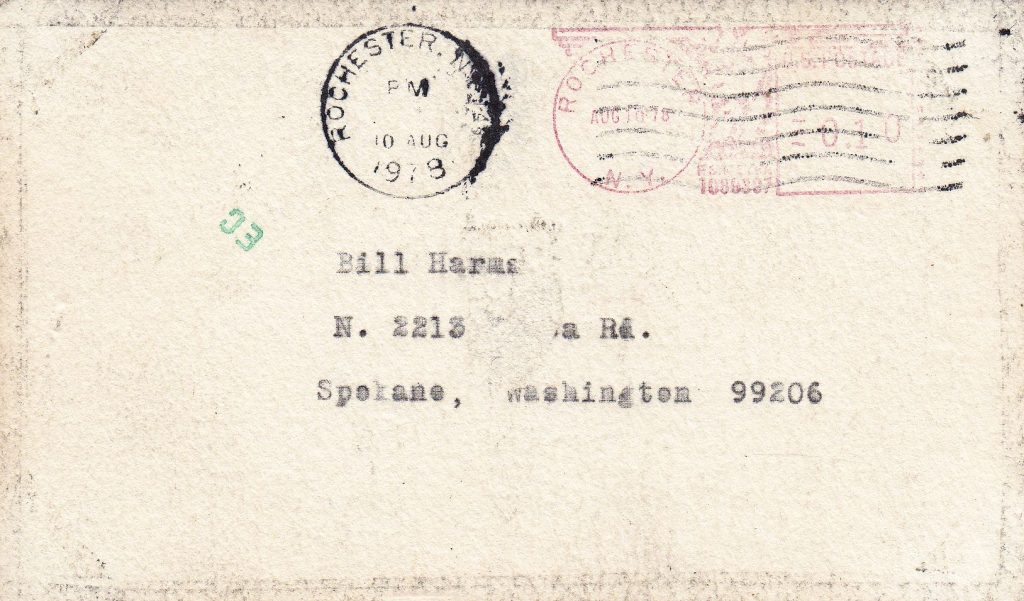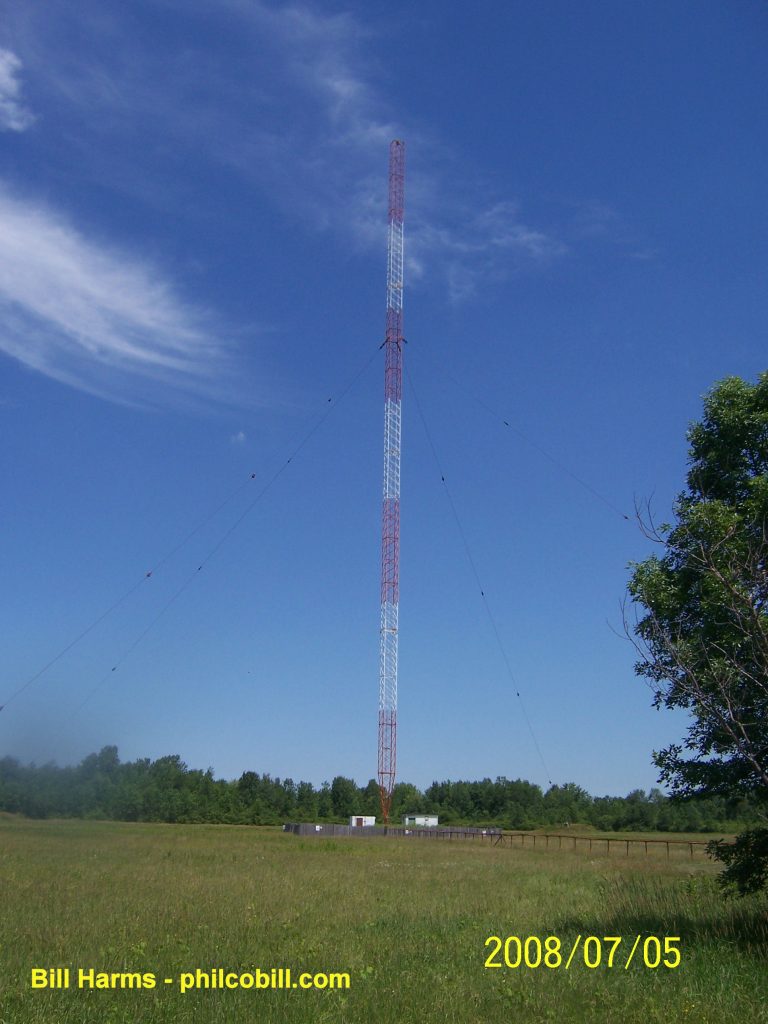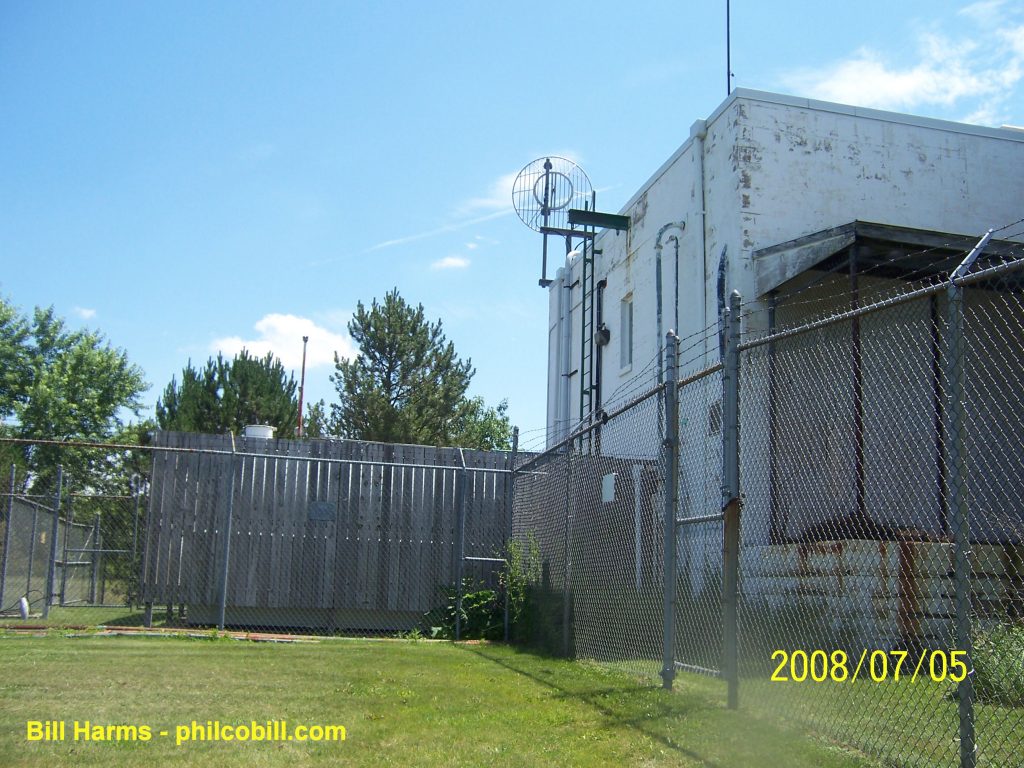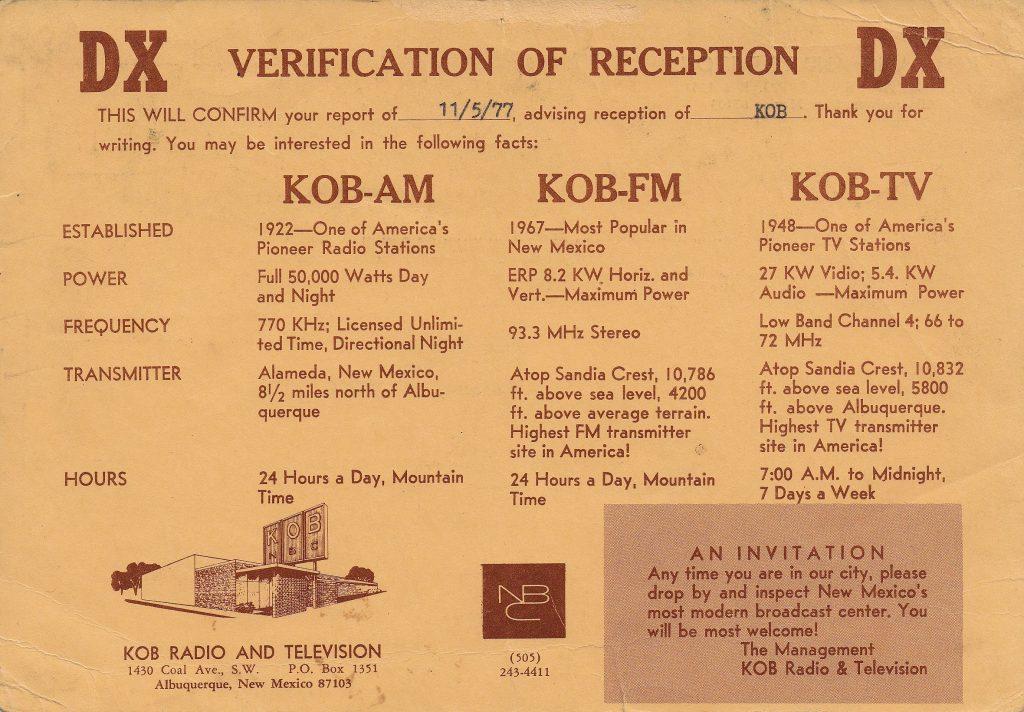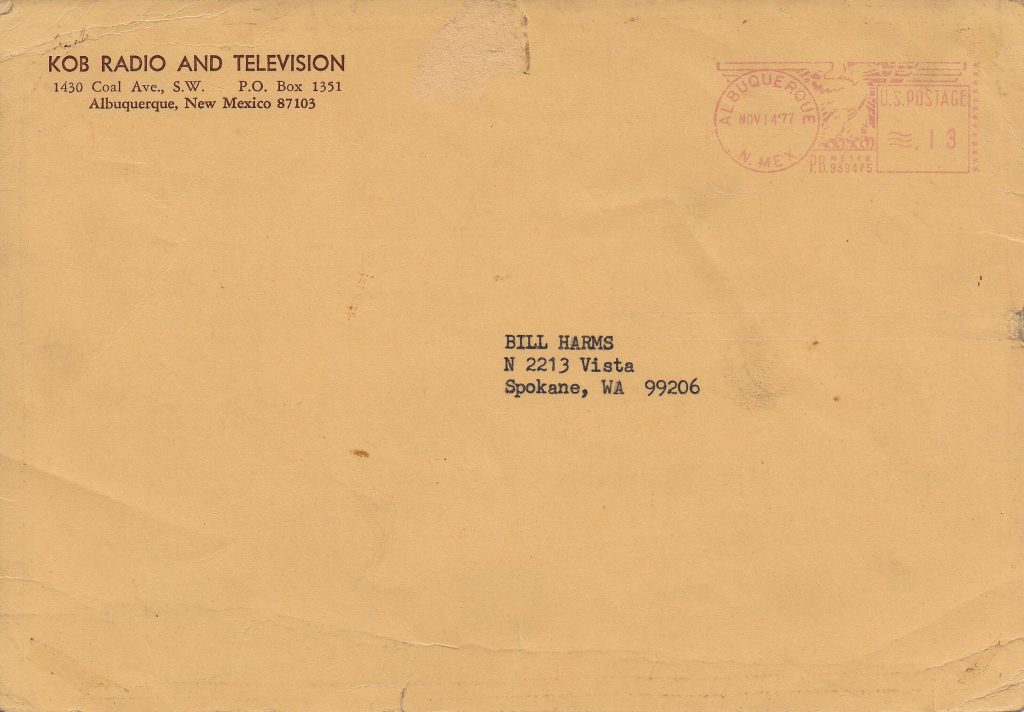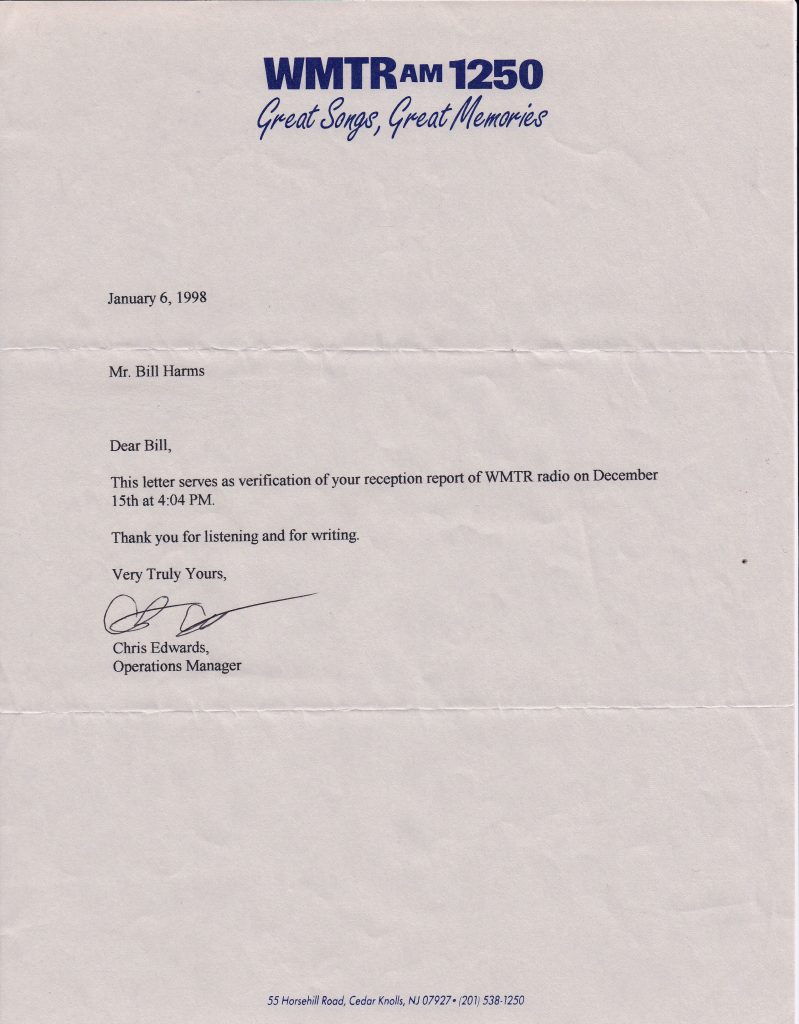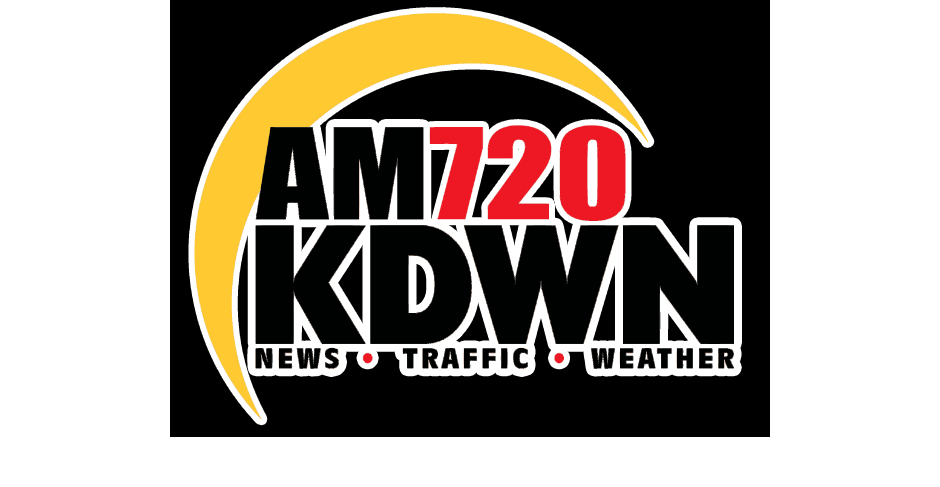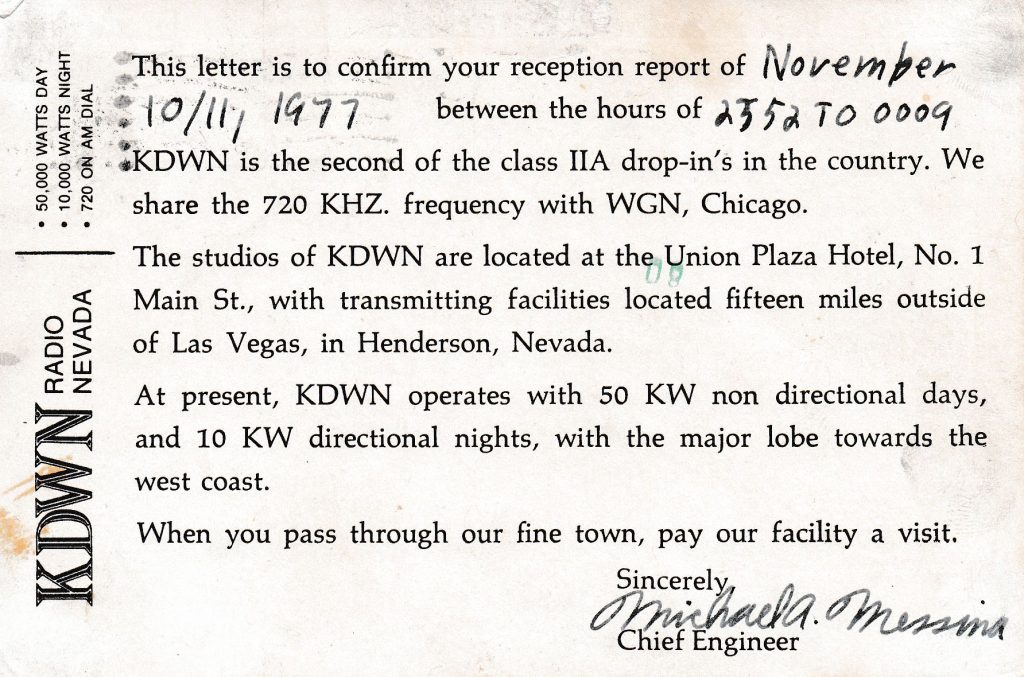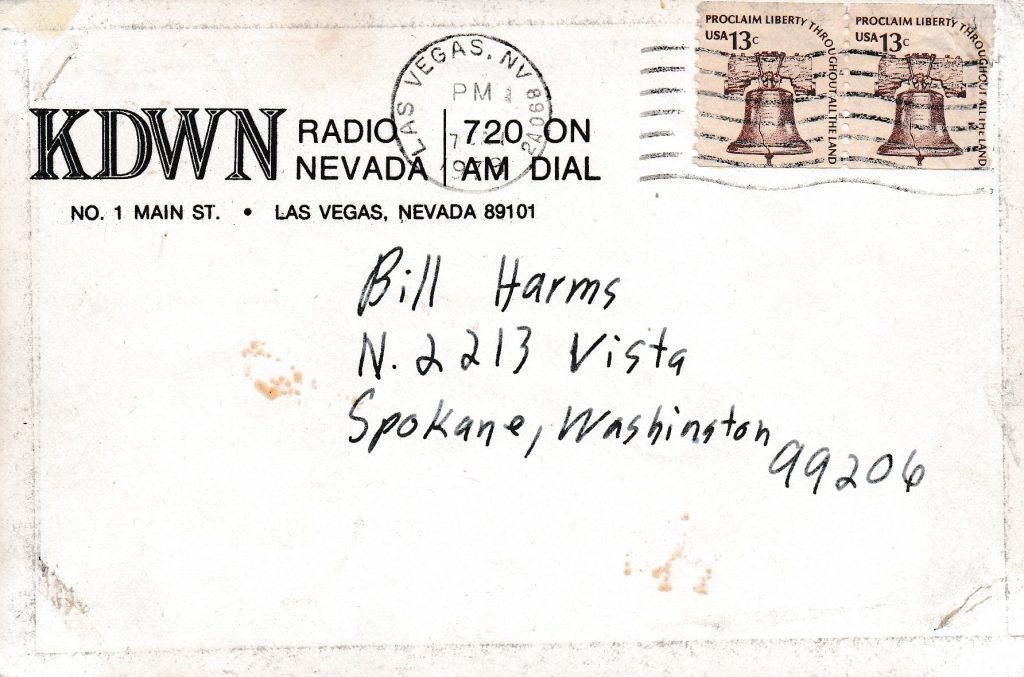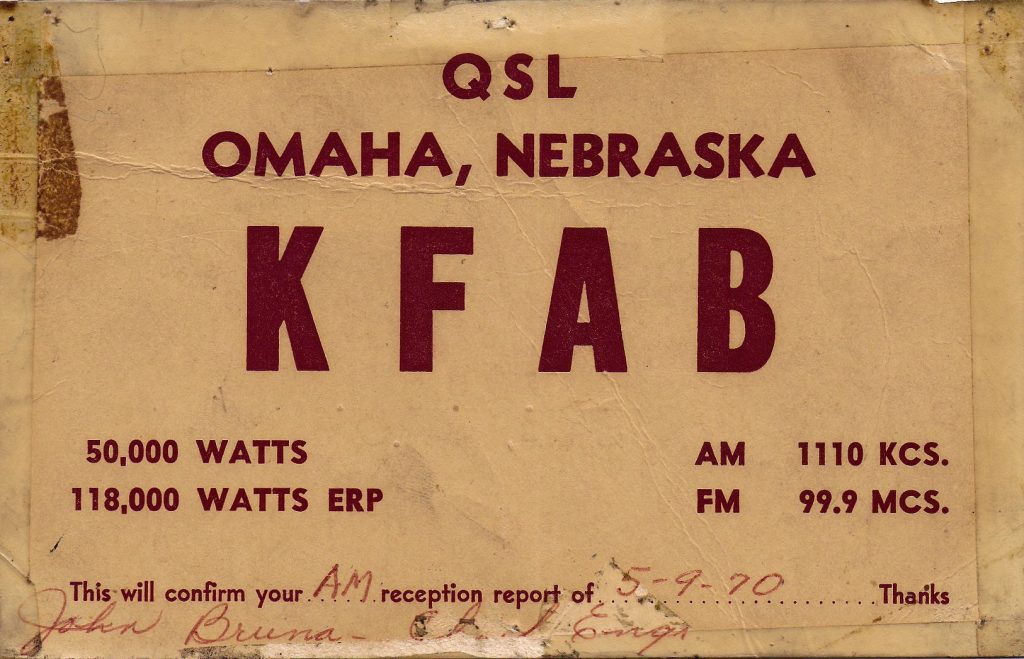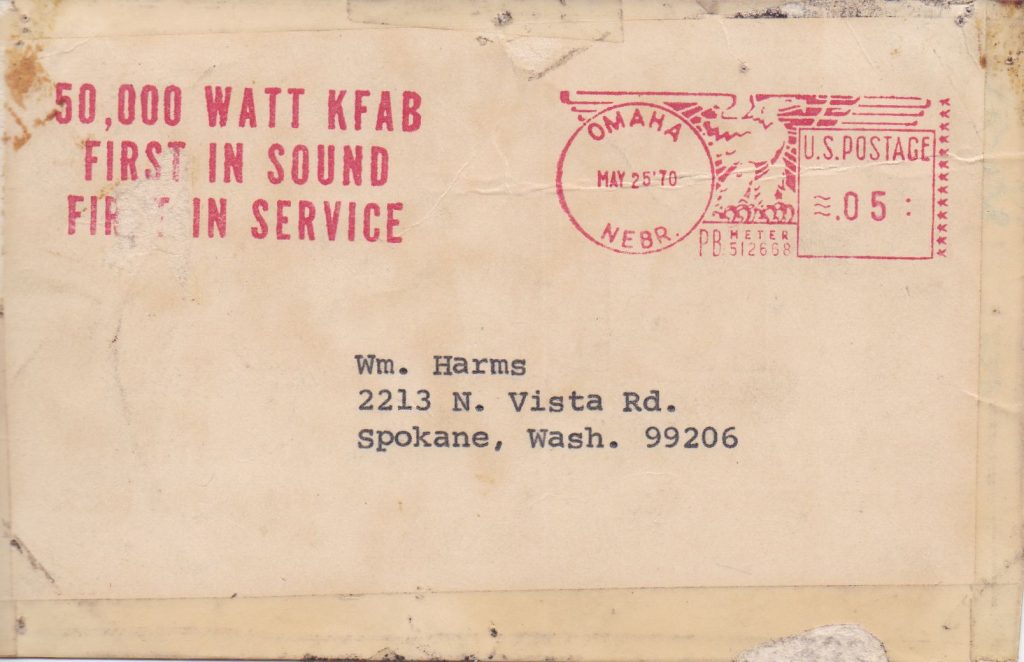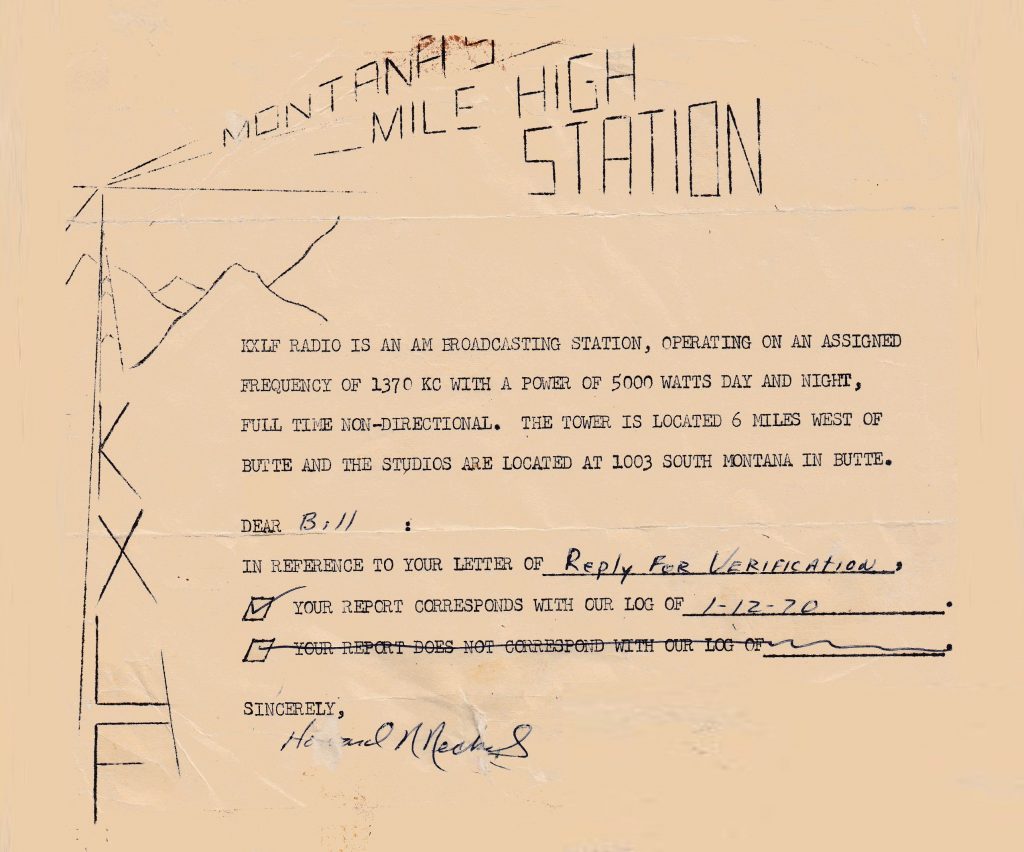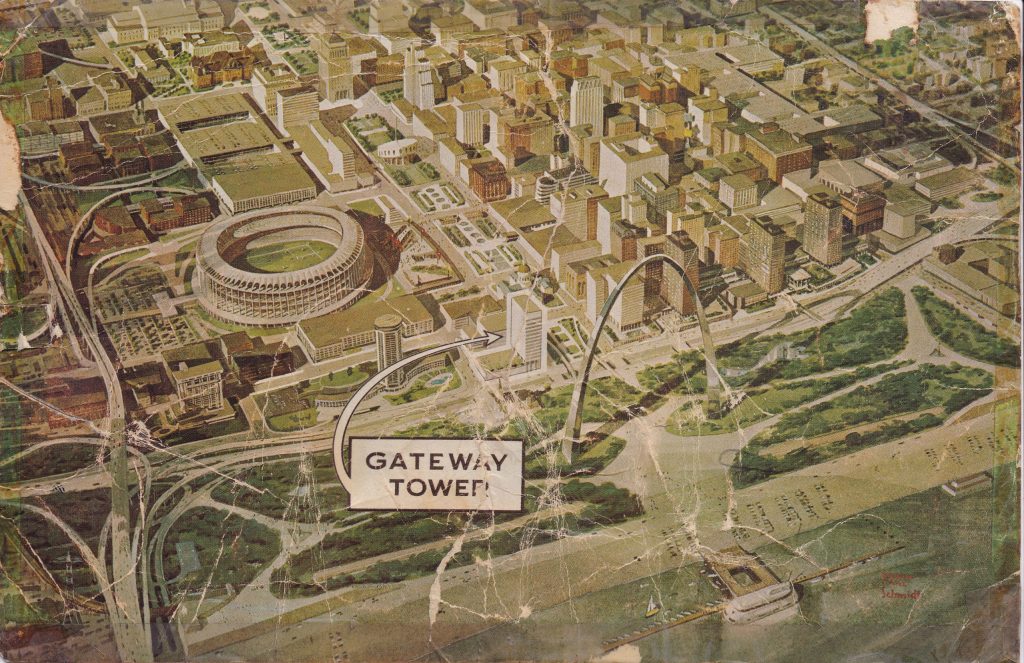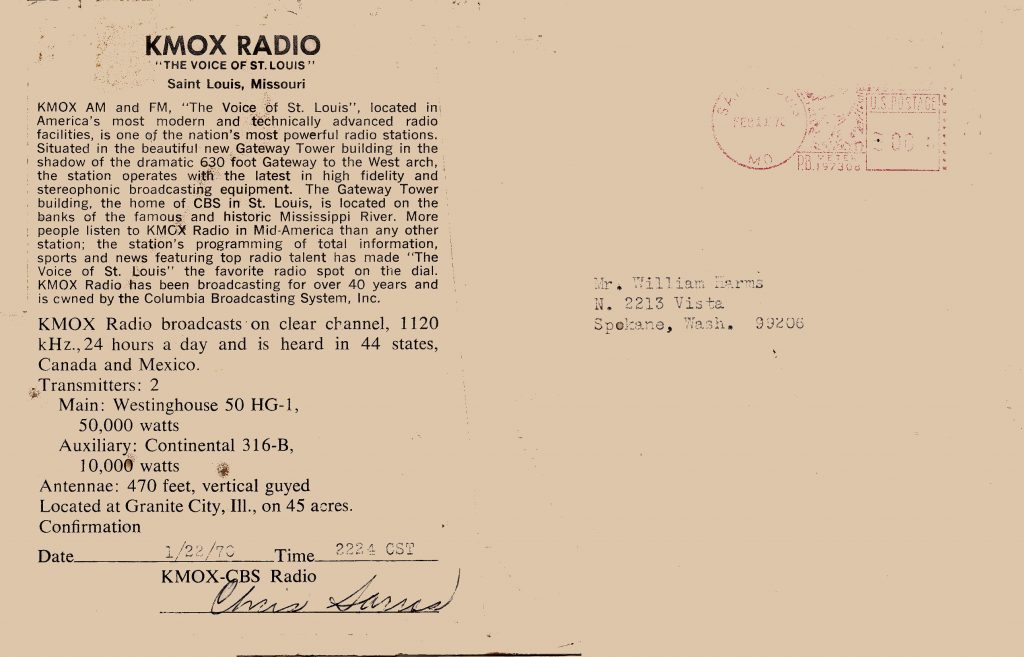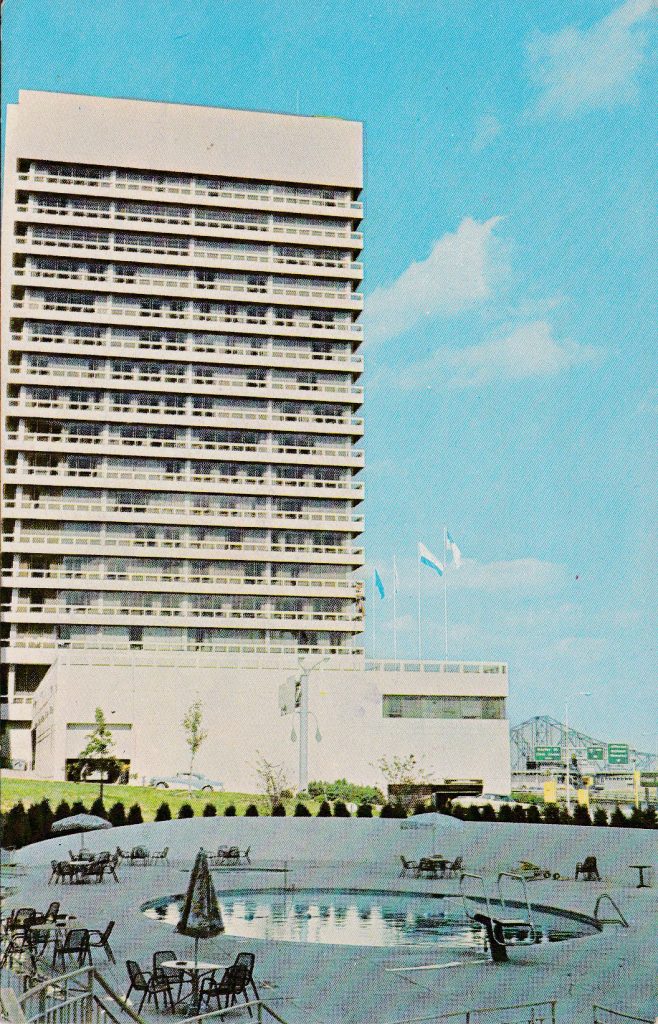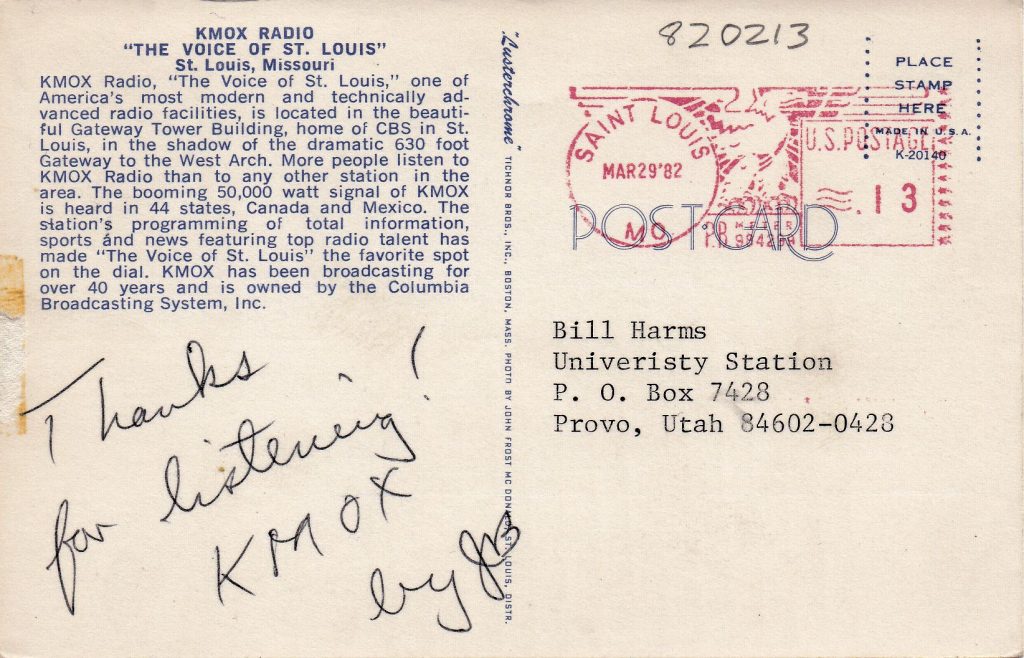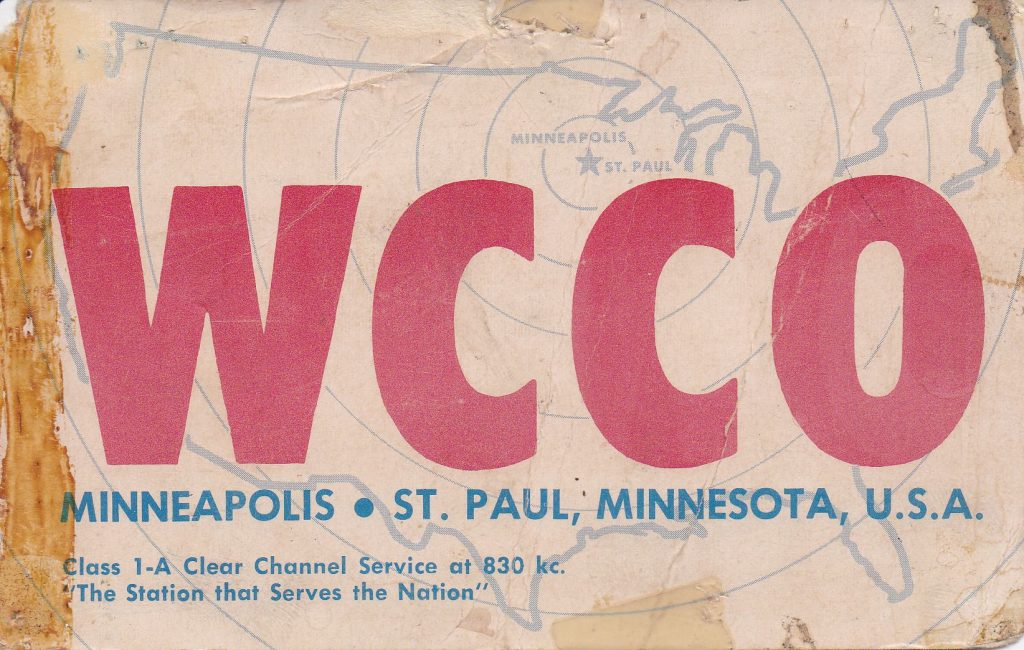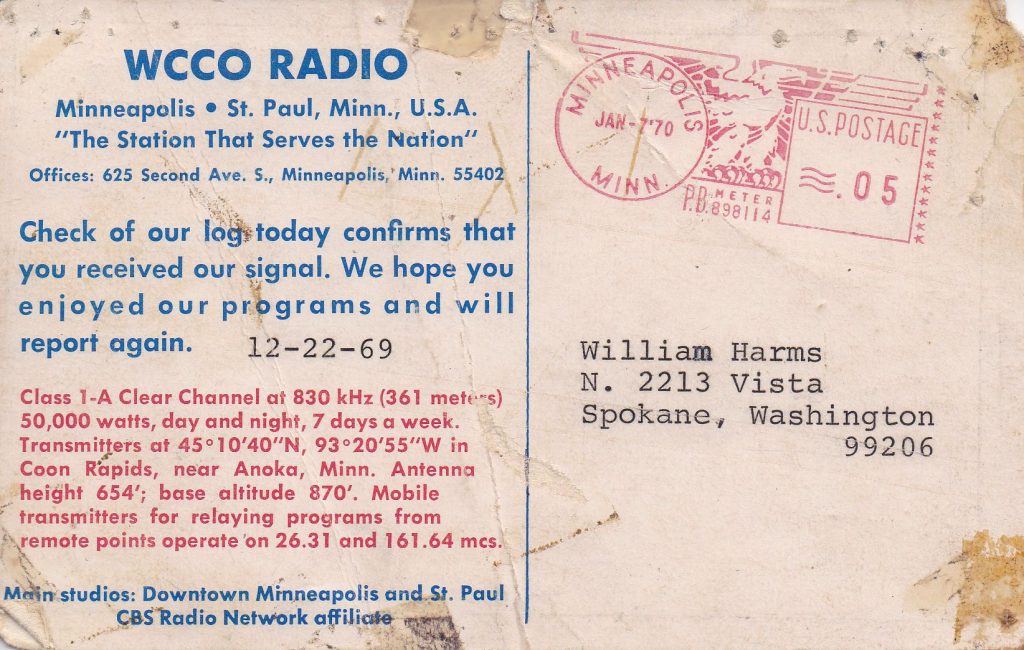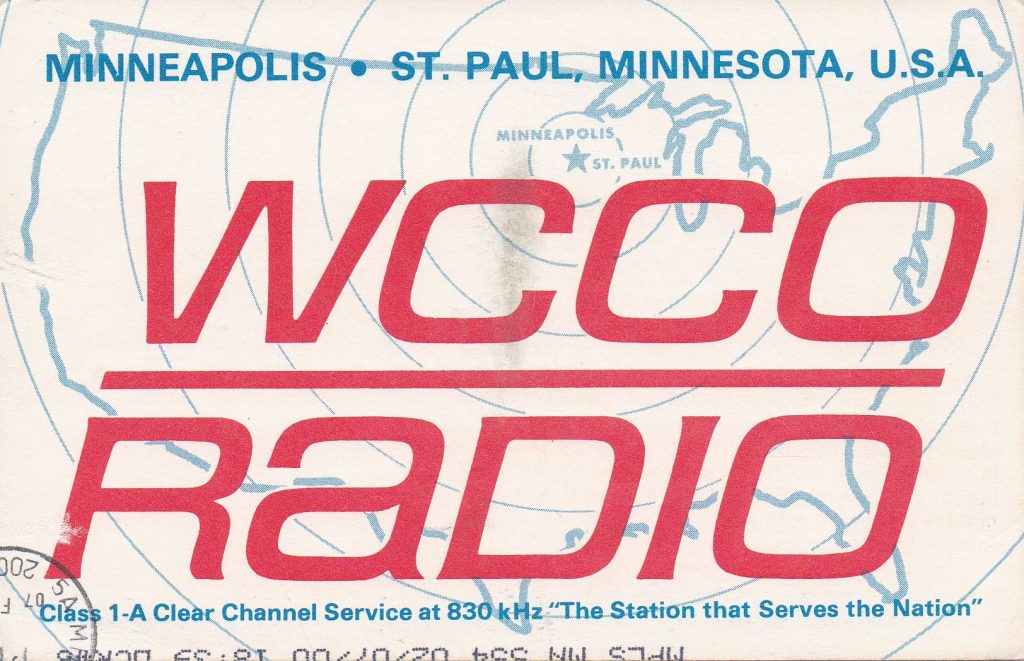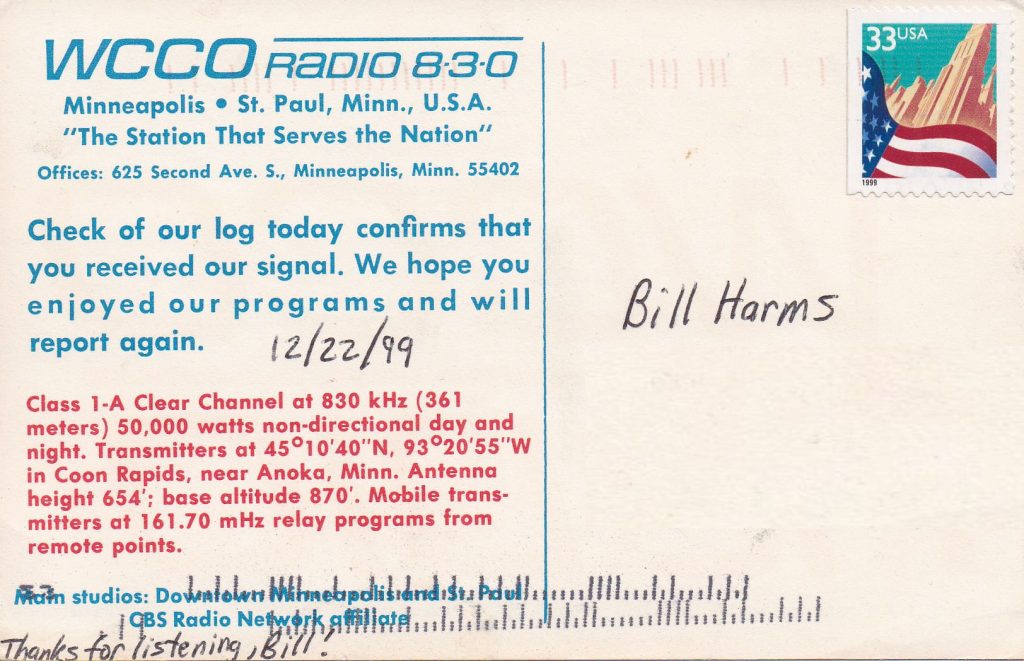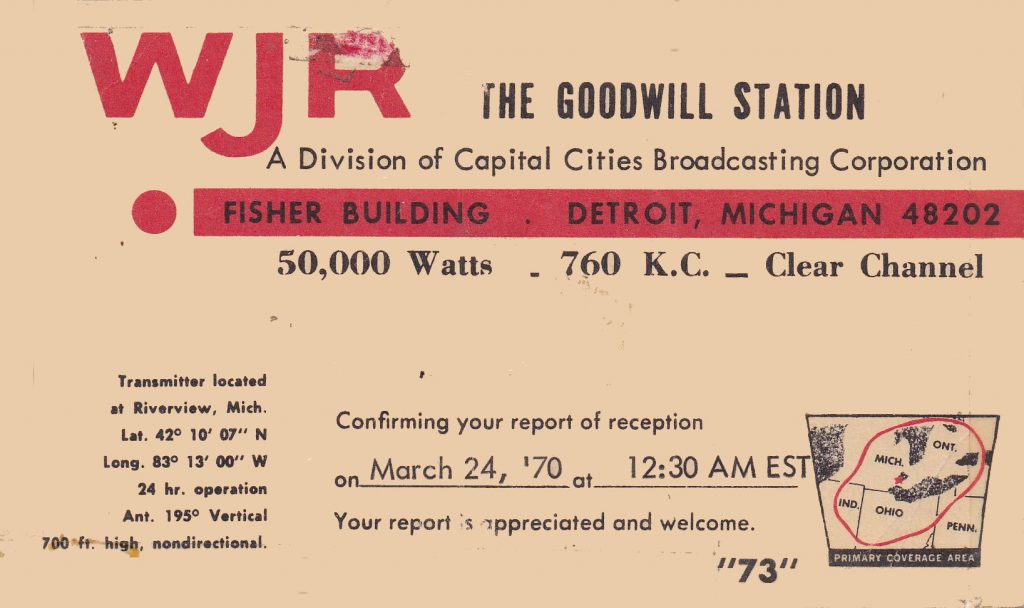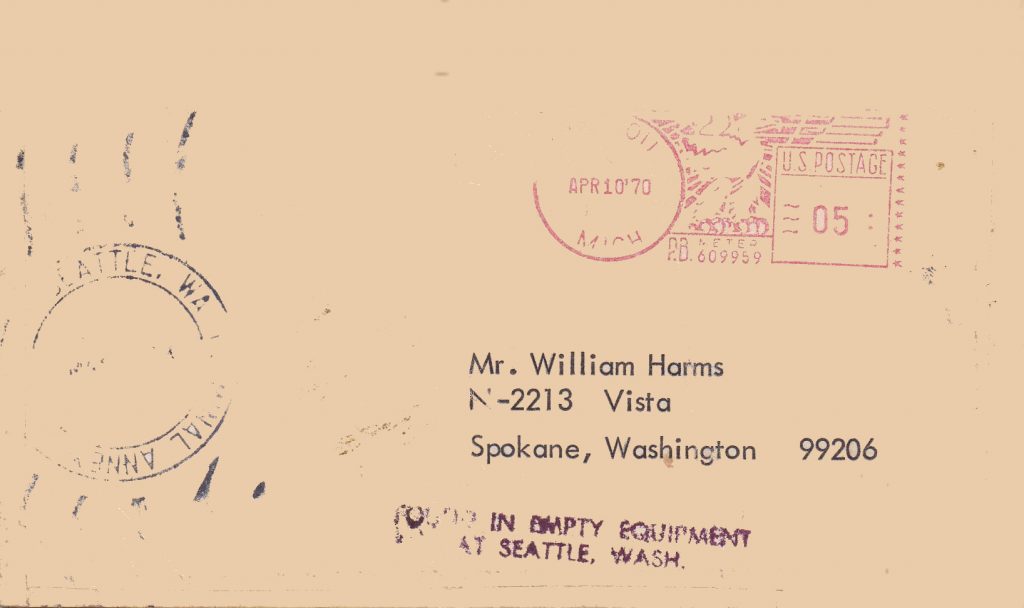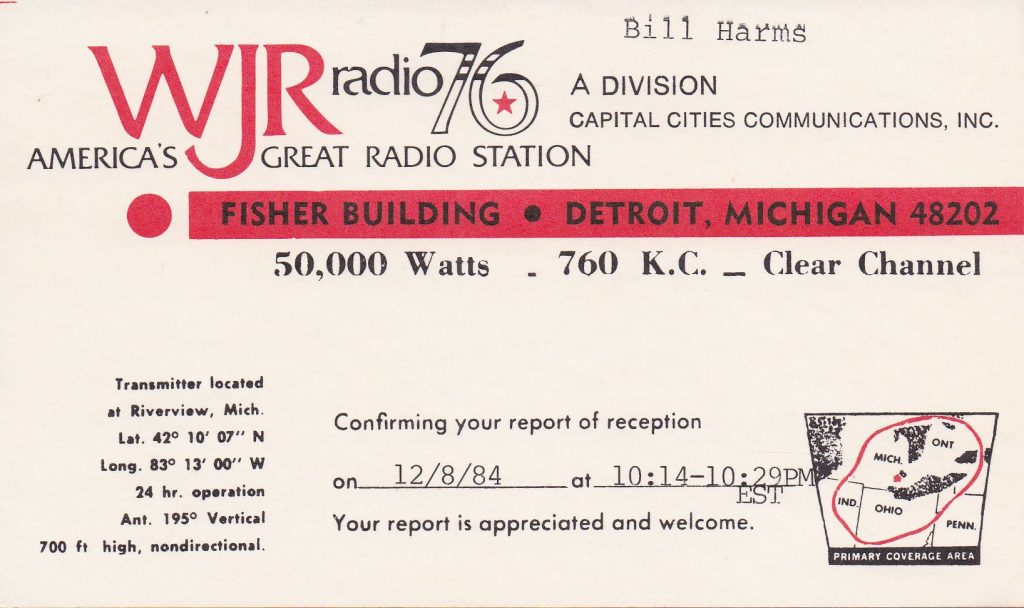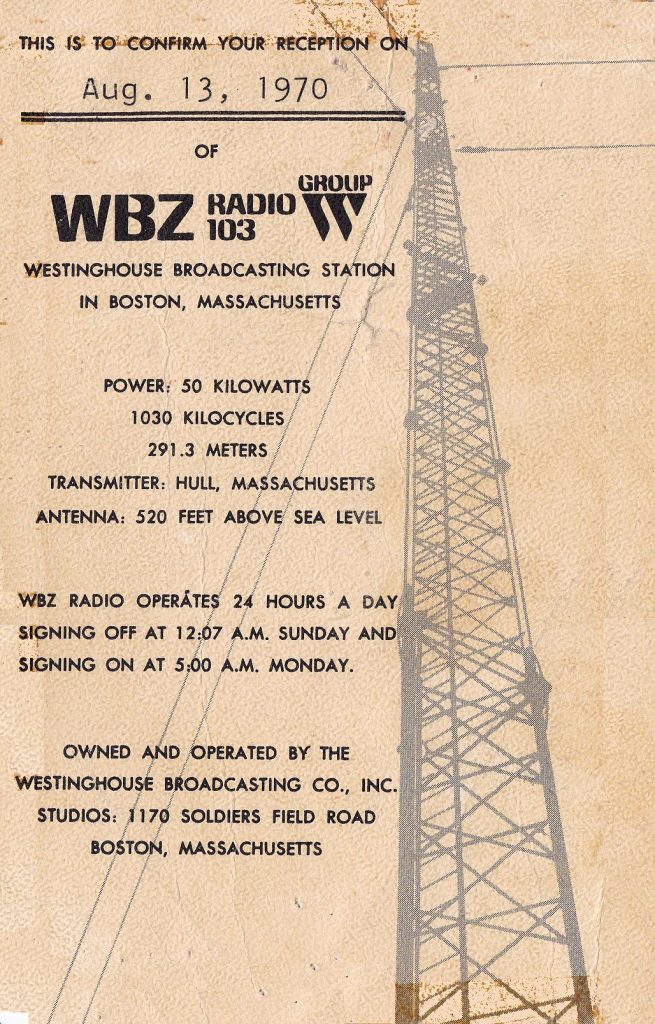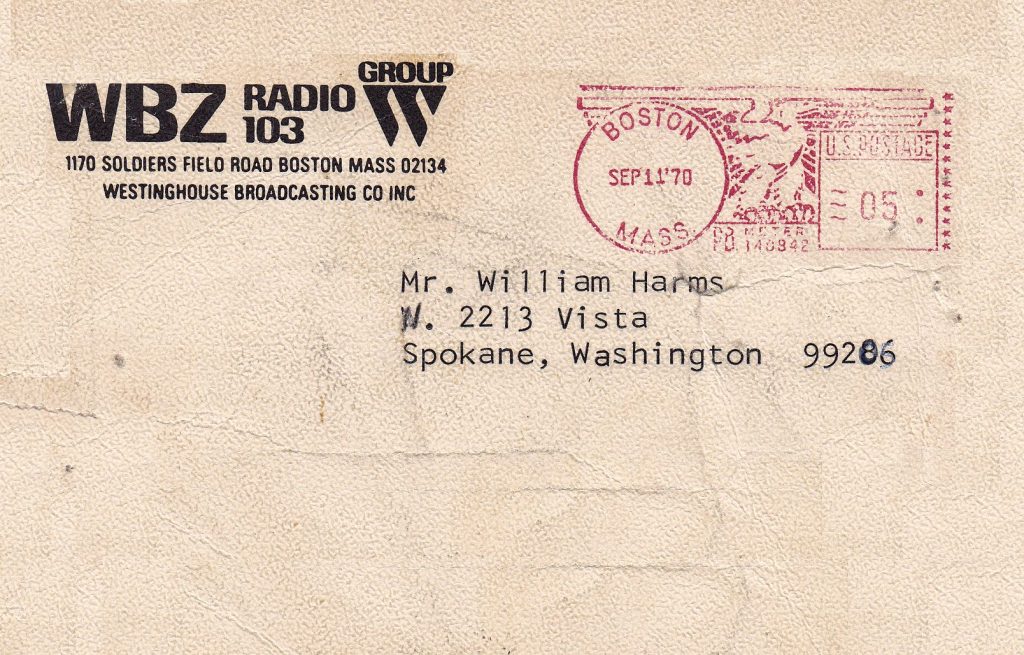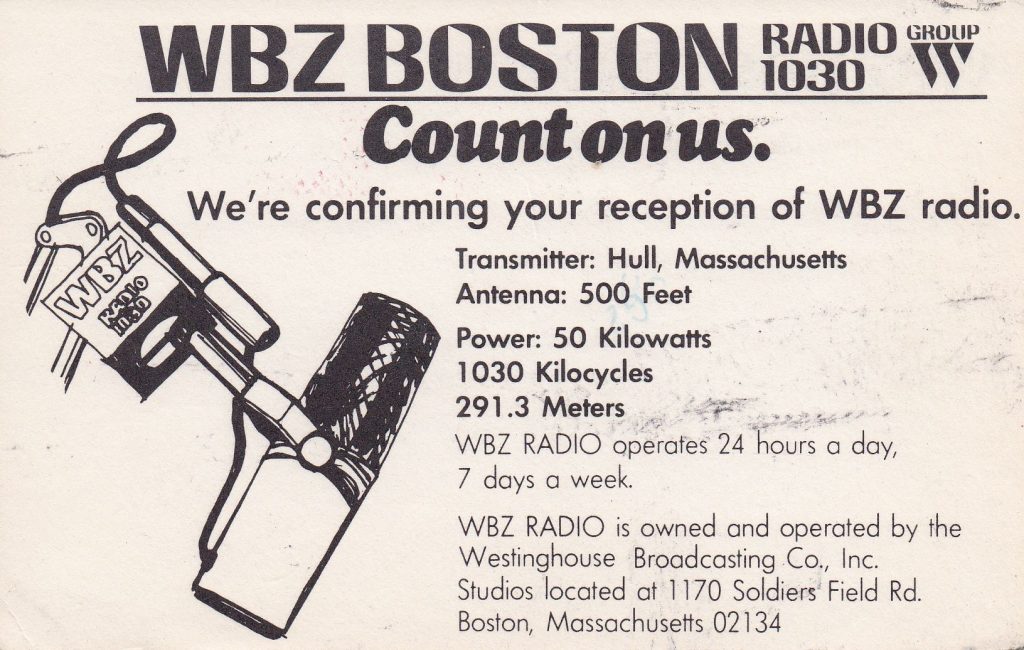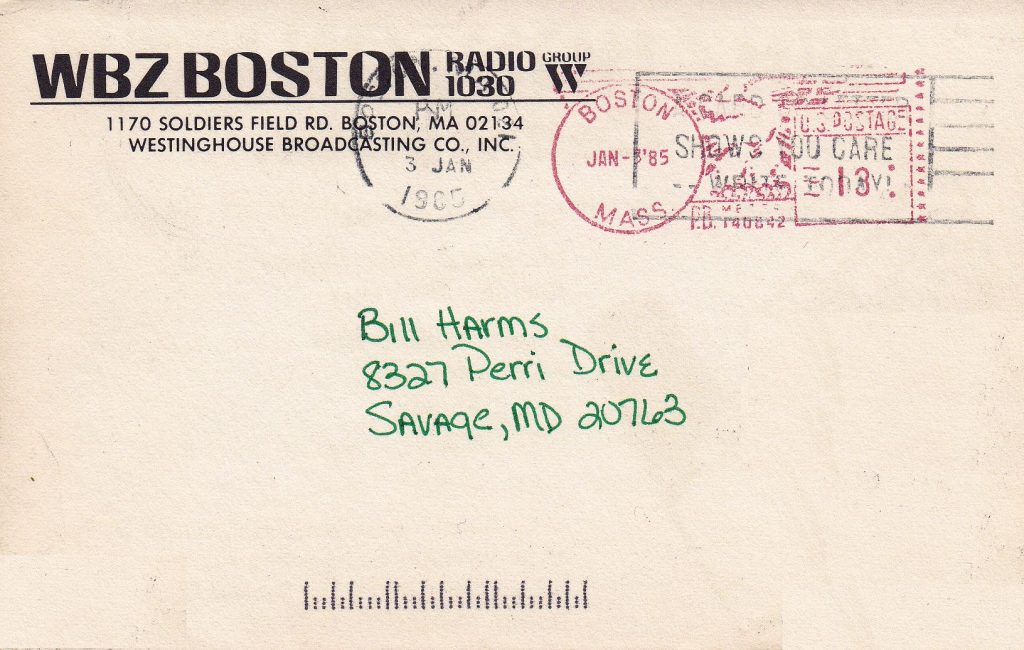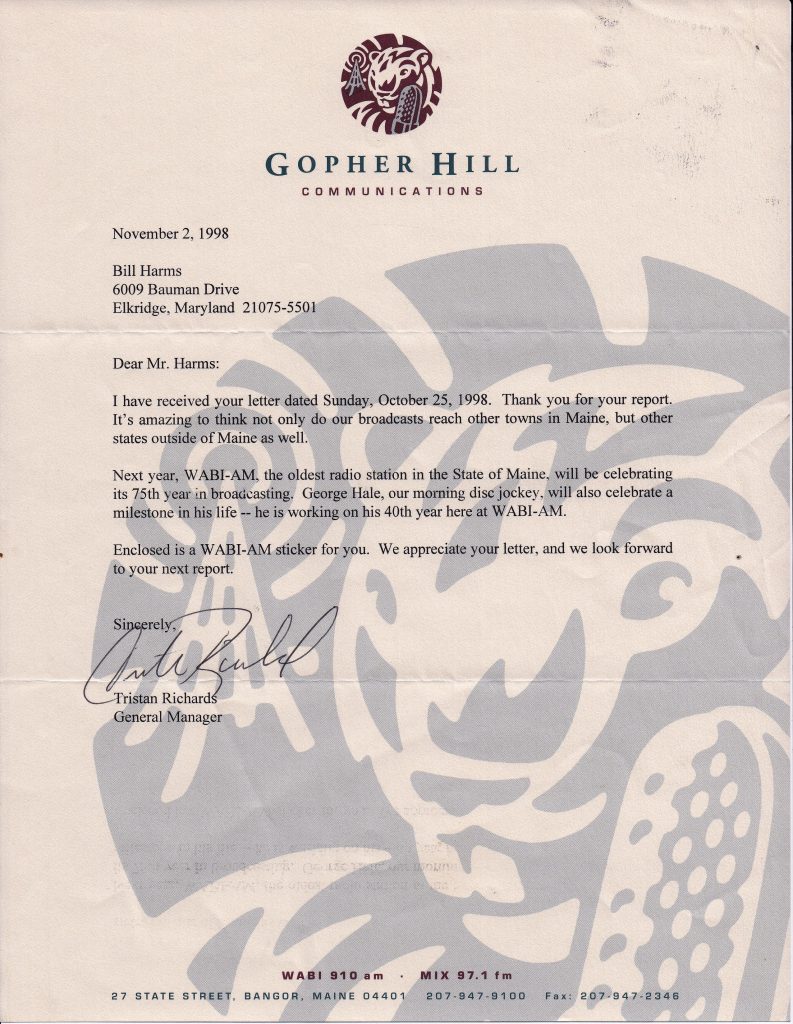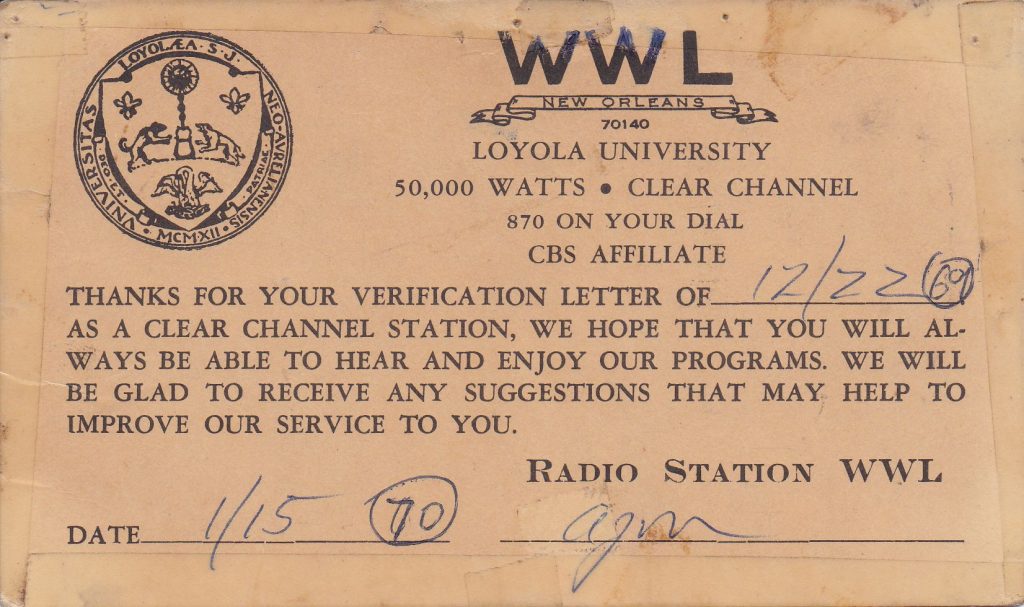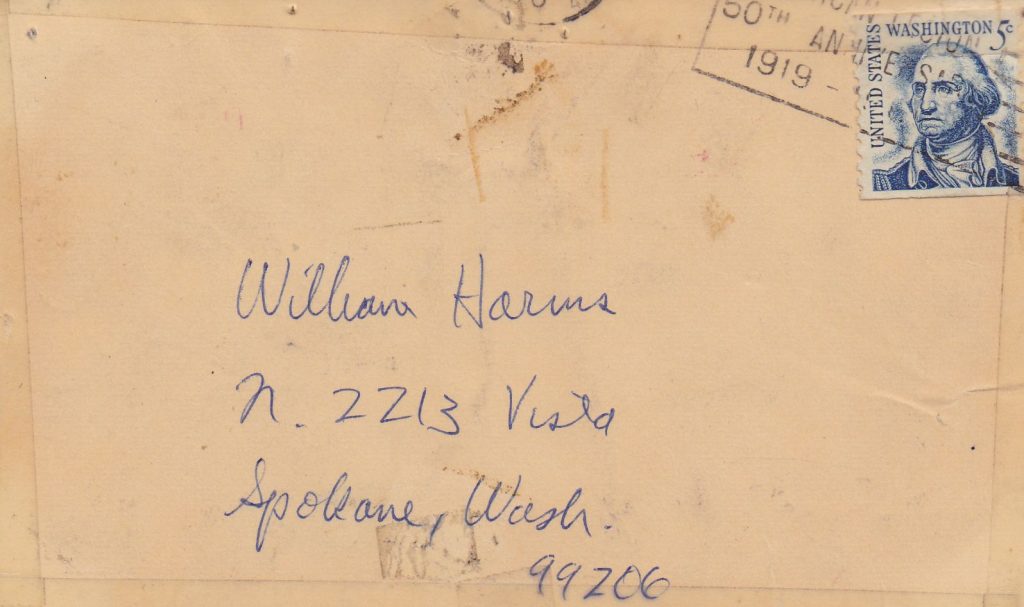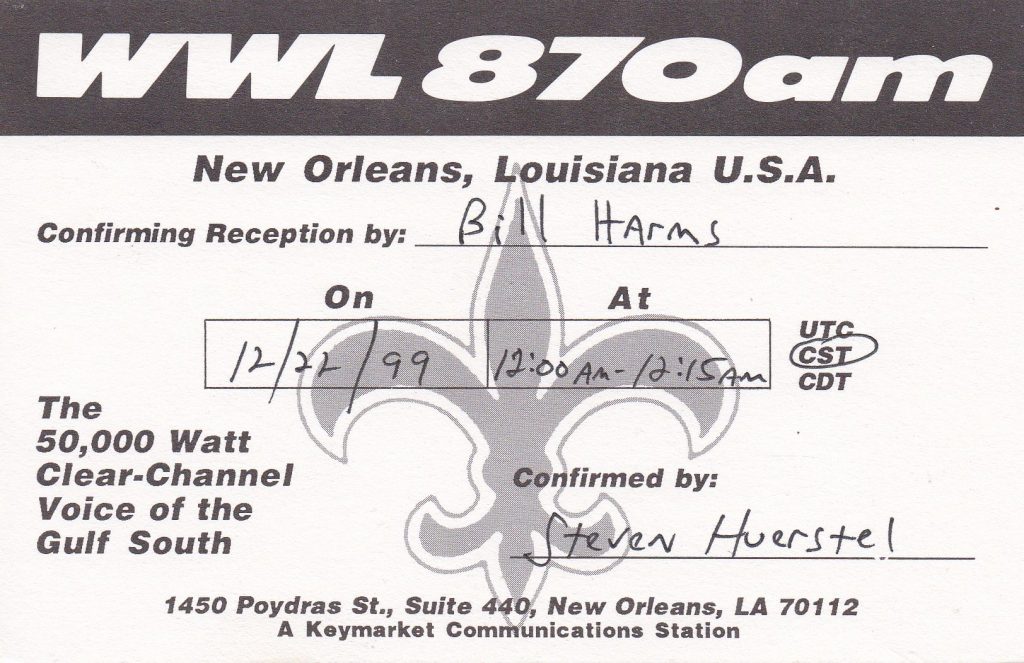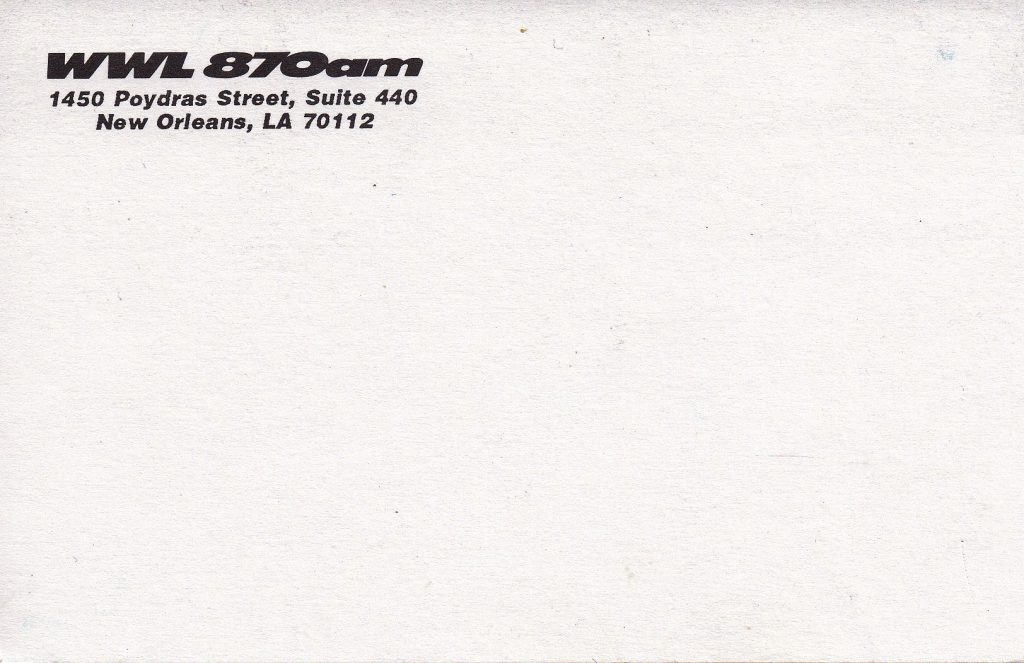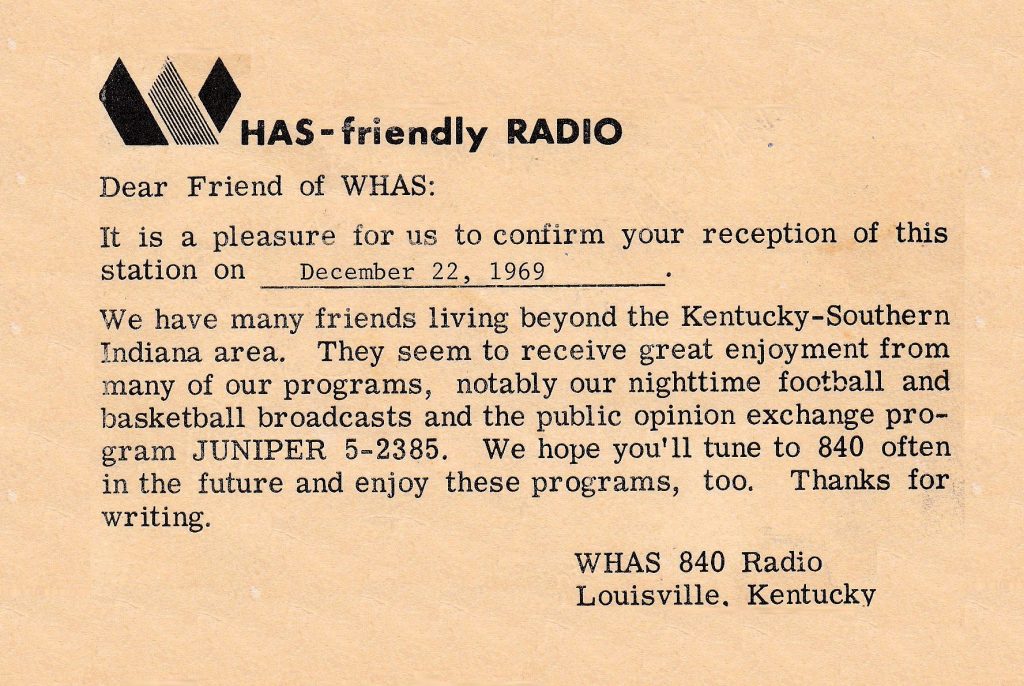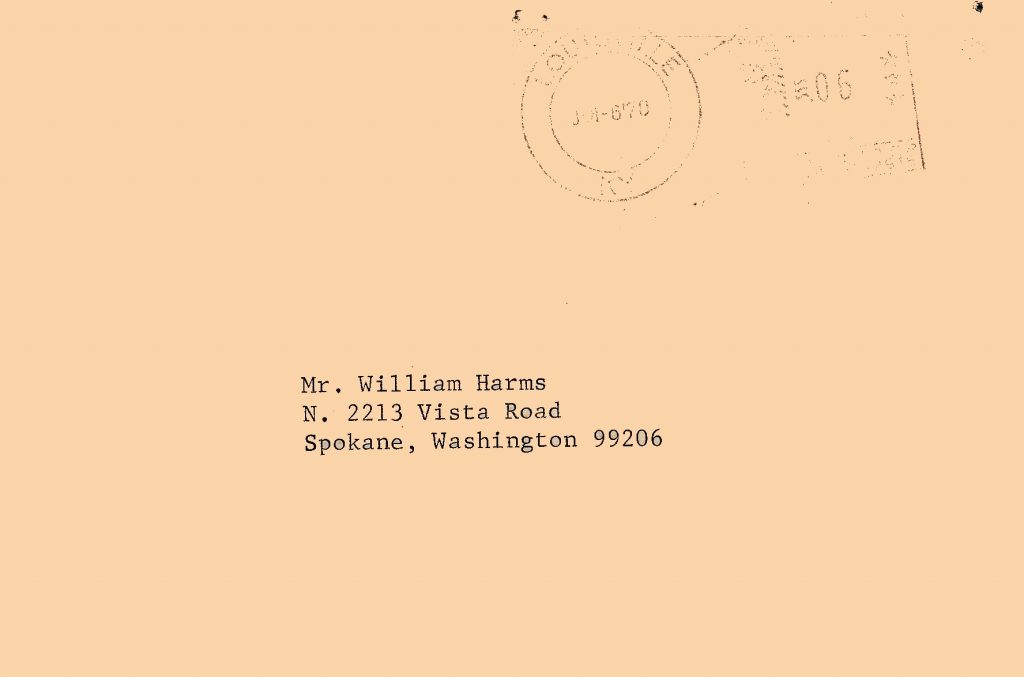KTWO first signed on the air in January 1930 on 1470 kHz. In 1967, they moved to 1030 kHz. With their 50 kW blowtorch (directional at night and non-directional in the daytime, they can get out well throughout Western North America. They have even made it to my Maryland listening post a couple of time with WBZ nulled. However, more recently, reception in Western North America is more difficult because of stations which have subsequently signed on.
I first heard them in Spokane in 1969 and they responded to my reception report with the QSL below.
Daily Archives: 12 January 2019
KTWO 1030
WEAQ 790
Eau Claire, Wisconsin
WEAQ 790 made to my listening post in Utah several times in the 1980’s, mainly on my roadside Beverage antennas. While on vacation in Minneapolis, I decided to send them a reception report and they responded with this QSL card.
WTAQ, WEAQ’s predecessor, first signed on in 1937. In 1996, WEAQ and WAVY swapped frequencies, the former to 1150 kHz and the latter to 790 kHz.
WWVA 1170
Wheeling, West Virginia
WWVA in Wheeling, West Virginia first signed on the air on 13 December 1926. From 1933 to 2008, WWVA was the home to the Original Wheeling Radio Jamboree (formerly Jamboree USA), the second-longest running program in radio history. The station’s format was country music until 1997 when the station’s owners switched to talk radio. The Jamboree program continues on the low power FM station WVOV-LP 101.1 in Wheeling.
WWVA beams its signal mainly to the east and can be heard in a large area on the East Coast of North America. I decided to send them a reception report just after we moved to Maryland, and they responded with the QSL card and letter below.
KGA 1510
Spokane, Washington
KGA 1510 in Spokane may have been the most widely heard station from Washington state. They first signed on the air on February 4, 1927. Although KGA has had several owners (including Gonzaga University), has changed frequency several times, and has had its studio and transmitter site relocated over the years, it has retained the same set of call letters from its founding. In fact, the call sign KGA has been continuously used in Spokane longer than any other set of call letters.
In the late 1960’s they were a Top 40 station competing against KJRB and KREM in the Spokane radio market. For many years following that, they were a popular country and western station. in 1994, KGA switched their format to news talk. In April 2008 they switched to a sports format. For further information about the history of KGA click here.
They were an easy catch in Utah and I have a tentative reception of them here in Maryland. They sent replied with a QSL to me for my 1974 reception in Utah for a report.
WRVA 1140
Richmond, Virginia
WRVA has been on the air since November 1925, making it one of the oldest radio stations in Virginia. WRVA’s format is a mixture of News, Talk, and Sports. Its programming is re-broadcast on two FM outlets.
One morning during Christmas vacation in 1977, WRVA Richmond, Virginia floated into my listening post in Spokane over the co-channel interference in 1140 kHz. I sent a report to them, and they responded with the QSL card below. They can be heard all day long here in Maryland via groundwave.
KSL 1160
Salt Lake City, Utah
KSL’s predecessor KZN first signed on the air on 6 May 1922. The station changed its calls to KSL in 1925 and has been using them every since. It is licensed to Salt Lake City, Utah and operates on 1160 kHz. It currently simulcasts its programming on KSL-FM on 102.7 MHz. From its beginning it has been owned by the Church of Jesus Christ of Latter-day Saints. It is the oldest radio station in Utah.
The station has aired the program Music and the Spoken Word since 1929 making it one of the longest running radio programs in the world. During the 1960’s and 1970’s, KSL aired the overnight talk show hosted by Herb Jepko.
KSL is synonymous with Utah in radio DXing circles. The station puts out a very strong signal at night and has been heard virtually all over the world. They were heard at night almost every time tried when I lived in Spokane. They replied to my three reception reports with three separate QSL cards.
WFAA 820
Dallas, Texas
When I first heard WFAA Dallas, Texas they shared air time with WBAP on 570 kHz and 820 kHz. Each station operated on the respective frequencies half the time. I sent a report to them after receiving them on 820 kHz.
WFAA’s predecessor KGKO in Wichita Falls first signed on in 1925. KGKO moved to Fort Worth in 1935 and changed call letters to WFAA in 1938. The shared time arrangement ended in May 1970 when WFAA stayed on 570 and WBAP stayed on 820. After several call changes for the station on 570, the current call letters KLIF moved from a station on 1190 kHz in 1990. The current format for KLIF is Talk Radio.
This is my first AM (Medium Wave – MW) QSL.
WSM 650
Nashville, Tennessee
WSM Nashville, Tennessee first signed on the air on 5 October 1925 and is primarily known as the home of The Grand Ole Opry, the world’s longest running radio broadcast. On their clear channel frequency of 650 kHz, they were widely heard across North America for many years. However, with the exception of a coverage area near Nashville, nighttime reception of WSM has become more difficult in more distant areas because of newer stations which now occupy the channel.
I remember listening to them in Spokane in the late 1960’s and into the 1970’s and was fascinated with hearing “The Grand Ole Opry” with the famous stars. They replied to my two reception reports with two QSL cards and a QSL letter. Visiting their station and The Grand Ole Opry is on my bucket list.
KSOO 1140
Sioux Falls, South Dakota
KSOO Sioux Falls, South Dakota would sometimes sneak through the co-channel din atop on 1140 with a readable signal in Spokane like they did in November 1977. They replied with this QSL letter for my reception report.
In August 2017, KXRB and KSOO swapped frequencies. KSOO moved to 1000 with its NewsTalk format, and KXRB moved to 1140 with its Country Music format.
WJXY 1050
Conway, South Carolina
WJXY Conway, South Carolina was a sunset skip reception on a fairly crowded channel (1050 kHz) when I heard them in 1983. At the time they had a country music format and was daytime only. I managed to hear a local ad and included that in my reception report. In response, they kindly sent back a QSL letter indicating that they ran the ad I heard.
At this writing, the channel is being used by WRWM on the Fox Sports Network.
The calls WJXY are being used by a station licensed to Atlantic Beach, South Carolina. The format is Urban Gospel and they use the slogan “Rejoice 103.5 & 1200.”
WHJJ 920
Providence, Rhode Island
WHJJ 920
Providence, Rhode Island
KDKA 1020
Pittsburgh, Pennsylvania
Pioneer radio station KDKA has been called the oldest broadcast station in the world, but that is the subject of semantics and controversy. However you define it, KDKA marks it first date of broadcast as November 2, 1920 when they broadcast the presidential and local election returns.
KDKA was a regular reception in Spokane in 1970 but this had to wait for KSWS and KGBS to sign off for the day. Currently, 1020 is a crowded channel with many newer stations on the air. This has made clear reception of KDKA difficult in much of North America.
They sent a 50th anniversary commemorative QSL card for my reception report. If they commemorate their 100th anniversary with a new QSL card, it would be cool to receive one from them.
KUMA 1290
Pendleton, Oregon
KUMA Pendleton, Oregon first signed on the air in 1955. On their present day 1290 kHz they can get out well. They were a sunset/sunrise catch on most every day when tried in Spokane. What is interesting is that I would sometime hear them all day long in Provo, Utah on my Realistic TRF in the winter. I sent them a report of one of these daytime receptions and they sent this QSL letter in response.
I believe I their format was country music for many years. Now they are a NewsTalk radio station.
KGYN 1210
Guymon, Oklahoma
Using 10,000 watts day and night on 1210 kHz, KGYN Guymon, Oklahoma was heard in a large area of the western United States in 1970. Currently, there are other stations on the channel in the West, making reception more difficult except near Guymon. I remember one evening in January 1970 when I tried for WCAU 1210 in Philadelphia, KGYN was there instead. So I sent a reception report to the station for which they responded with the nice QSL card which features the Oklahoma Panhandle.
Today, KGYN’s format is full service featuring news, sports, and agricultural programming.
WLW 700
Cincinnati, Ohio
Scroll down to see QSLs
WLW Cincinnati, Ohio is a pioneer station that was first licensed in March 1922. In the late 1920’s they were called “the Nation’s Station.” In 1934, WLW was a superpower radio station. After midnight, they transmitted with 500,000 watts using the call letters W8XO.
In the 1970’s and before they covered a large part of North America. They were an easy catch in Spokane in the winter on most nights. However, the channel has since become cluttered and it is now difficult to hear them on the West Coast. However, they are in the clear with a huge signal here in Maryland. They sent me a QSL card for my 1970 reception report.
WDAY 790
Fargo, North Dakota
See QSL images below.
WDAY is a pioneer radio station which was first licensed in May 1923 with their present call letters, making it the oldest radio station in North Dakota. Also, they are one of the few stations west of the Mississippi with calls that start with “W” because they were licensed before the Mississippi Rule for license allocations.
In Spokane, WDAY 970 in Fargo, North Dakota was a rare catch in the 1970’s because of the local station KREM. Even when they signed off, KOOK in Billings, Montana and KOIN in Portland, Oregon usually played havoc on the channel. On Christmas morning in 1971, KREM, KOOK, and KOIN were off the air, so I decided to send a reception report to WDAY. They sent this QSL card in response. If my memory serves me, they were playing Christmas music.
As of this writing, WDAY’s format is NewsTalk.
WCPS 760
Tabor, North Carolina
WCPS in Tabor, North Carolina is a 1000-watt daytime only station on 760. In December 1983, I strung up a 1500 feet beverage antenna beside a road near our home just to see what could here during daylight hours. I was surprised when WCPS topped the channel. Janis Harper, program manager at the station sent this QSL letter for my reception report. They first signed on the air in January 1947 and their current format is a mixture of Urban Gospel, Urban Oldies, and Blues.
WHAM 1180
Rochester, New York
Back in 1970’s, WHAM Rochester, New York could be heard in Spokane with good conditions after KOFI in Kalispell, Montana signed off. Now 1180 is another cluttered channel making reception of WHAM difficult in Western North America even if KOFI were off the air. They sent this QSL card for my reception report.
I visited the transmitter site with Scott Fybush in 2011. See my photos below.
KOB 770
Albuquerque, New Mexico
KOB was a pioneer broadcaster in New Mexico that was first licensed in 1922. In the 1970’s, it transmitted from Albuquerque, New Mexico on 770 and was easily audible throughout Western North America. They sent this nice QSL card for my 1977 reception report.
Since then, the channel has become cluttered with other stations, making clear reception virtually impossible except near Albuquerque. The station changed call letters to KKOB in 1986 and its current format is NewsTalk.
WMTR 1250
Morristown, New Jersey
WMTR in Morristown, New Jersey can dominant 1250 here in Maryland at sunrise and sunset, especially in the winter. They replied to my reception report with the following QSL letter. Their current format is classic oldies.
KDWN 720
Las Vegas, Nevada
KDWN 720, Las Vegas, Nevada is an easy catch in Western North America, although it had to contend with WGN for channel dominance at times when I listened to them in Spokane. They did a little better in Utah when I lived there.
KFAB 1110
Omaha, Nebraska
KFAB 1110 in Omaha, Nebraska really gets out throughout a large part of Western North America. This is my first Nebraska station QSL in my collection.
KXLF 1370
Butte, Montana
KXLF Butte, Montana with their Top 40 format was many times the channel dominant on 1370 kHz in 1970 in Spokane. Their signal would boom in so strong, that they sounded like a local. I thought it would be cool to send them a reception report and they replied with the QSL sheet below.
Now KXTL holds down this channel in Butte. I heard them with oldies in July 1994. As of this writing, their format is Talk Radio. (Scroll for the audio clip of this reception.)
KXTL 1370 – Butte, Montana audio clip
KMOX 1120
St. Louis, Missouri
Due to its location in the middle of the USA and its 50 kW flame thrower transmitter, KMOX is a relatively easy catch throughout much of the USA and Canada. It first signed on the air in 1925, making it a radio station pioneer.
They replied with the two QSL cards below for my reception reports.
WCCO 830
Minneapolis, Minnesota
WCCO Minneapolis is one of my all-time favorite stations.
I remember the first time I heard WCCO. When I mention it to my Dad, he told me me that he used to listen to them all the time when he was a boy in Wisconsin. They have been a strong market force in the Greater Twin Cities area since their very beginning. When stayed up all night listening to the radio one time, I decided to send them a reception report, for which they sent a QSL card.
Over the years, WCCO has been a favorite of mine. I always enjoy listening to them whenever I come across them on the radio dial. Also, my wife, who is from Minneapolis has fond memories of listening to them.
I hope to be able to have many more years of connecting with WCCO in the future as I have had in the past 50 years.
WJR 760
Detroit, Michigan
It was so cool picking up WJR 760 Detroit, Michigan when I first started to DX in Spokane. After hearing them numerous times during the 1969-1970 DX season, a reception report was off to them in March 1970. A reply came several weeks later after being delayed in en route. They almost always (auroral conditions excepted) put in a rock sold signal at night here in Maryland.
WBZ 1030
Boston, Massachuesetts
Pioneer station WBZ first received its license in 1921 which makes it the oldest broadcast station in New England. With its 50,000-watt transmitter on 1030 kHz, it covers most of New England by day and much of Eastern North America by night. In the 1970’s it would easily make it all the way to the West Coast at night especially after KTWO in Casper, Wyoming signed off at midnight local time. 1030 was one of my favorite channels at night. I would tune my radio to 1030 before going to bed and listen to KTWO and then WBZ.
They replied with the QSL card below for a reception report that I sent to them.
WANN 1190
Annapolis, Maryland
WANN 1190 Annapolis signed on the air in 1947 and went off the air in 1998. Mr. Morris Blum, General Manager replied to my reception report with a QSL card and a QSL letter. Soon after WANN went off the air, the transmitter site in south Annapolis was demolished and WBIS started transmitting on 1190 duplexing from WNAV 1430’s transmitter site.
(For the rest of the story scroll down to bottom of the page.)

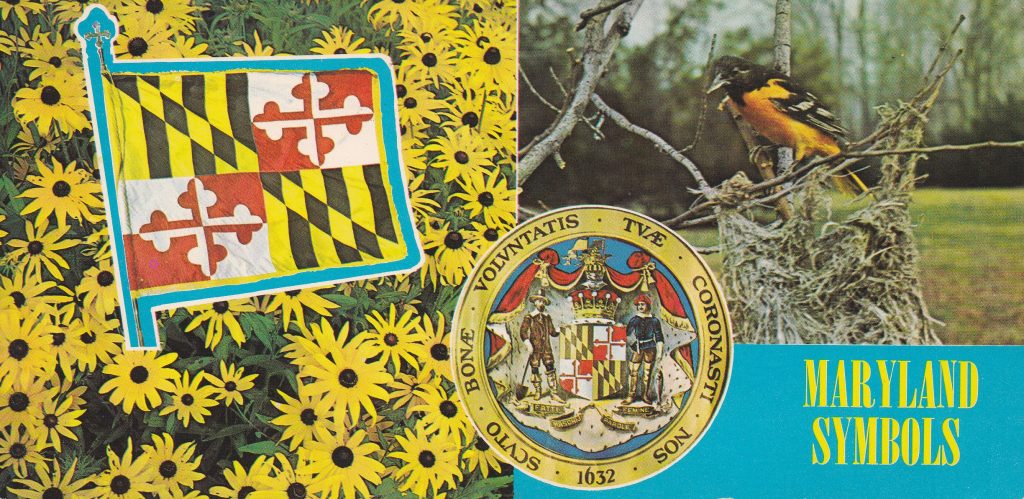
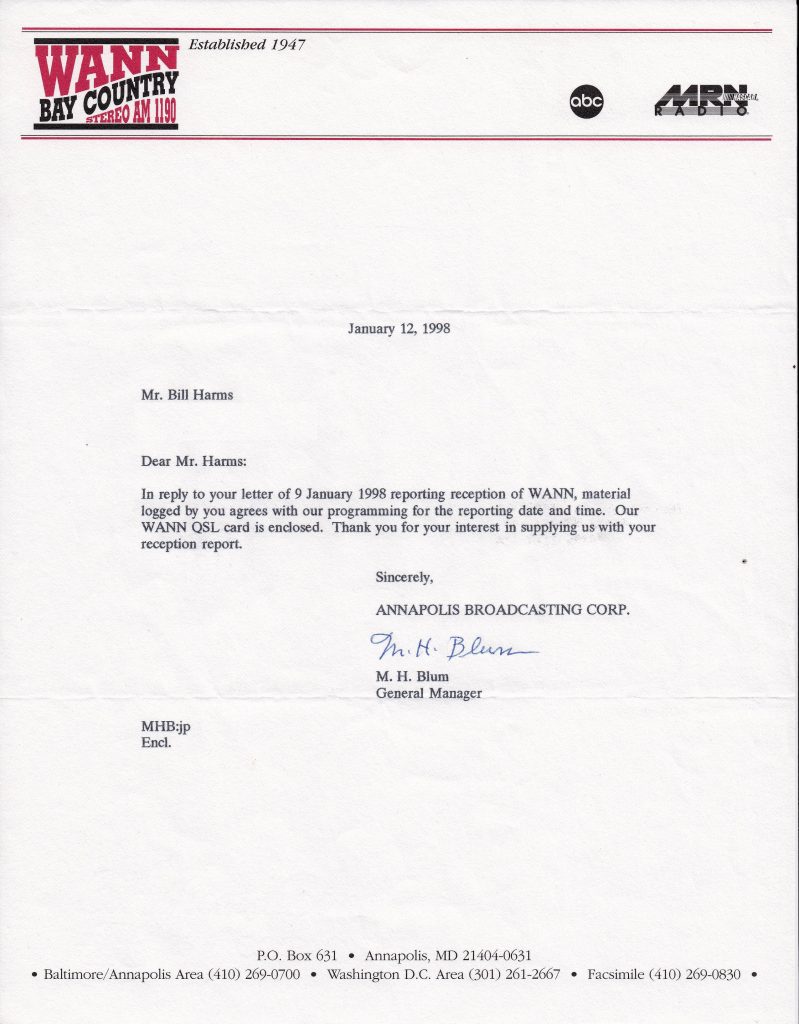
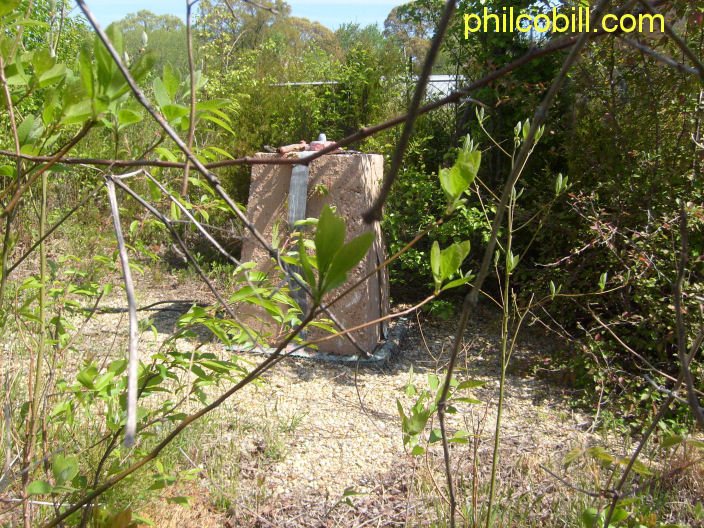
One of the tower bases – JuneWA 2007 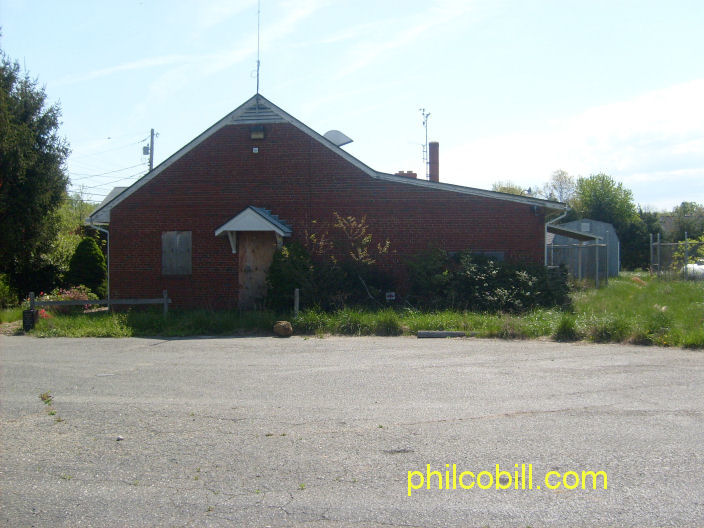
WANN studio and office building 2007 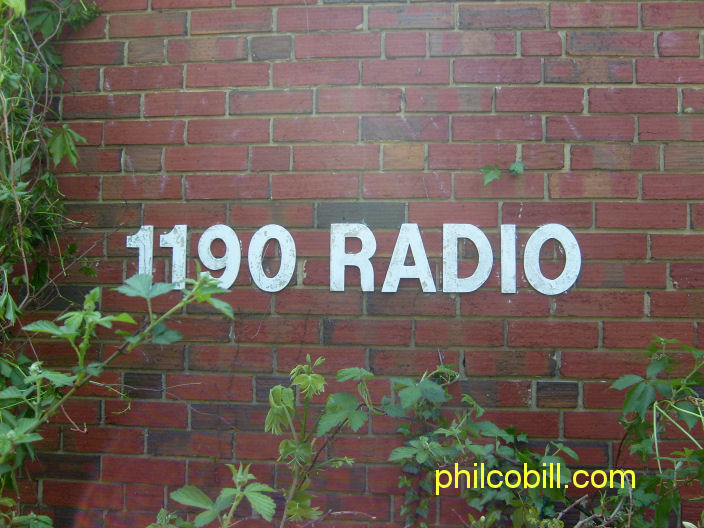
Outside of WANN studios and offices 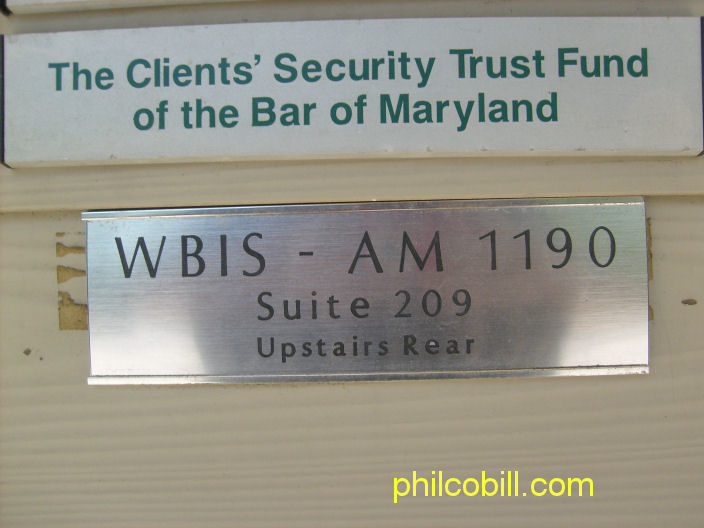
Door to WBIS 1190 office and studios in Annapolis
The WCRW or China Radio International Chapter
China Radio International bought block time on WBIS until early 2011. Later in 2011, Potomac Radio Group started to broadcast on 1190 kHz using the call letters WCRW transmitting from WAGE Leesburg’s transmitter site which had been using 1200 kHz. This meant that the license for 1190 in Annapolis was deleted. WCRW has been broadcasting programs from China Radio International on 1190 kHz since then.
WABI 910
Bangor, Maine
WABI 910 in Bangor, Maine blasted into Maryland one evening in October 1998. They replied with this nice QSL letter for my reception report.
WWL 870
New Oreans, Louisiana
WWL 870 with its 50 kW clear channel signal is widely heard at night in North America. They played a major role in providing information to a large audience after Hurricane Katrina in 2005. However, with more stations occupying the channel, getting clear reception of WWL is more difficult in many areas. I first picked them up on 22 December 1969 and sent them a reception report. In response they sent a QSL card. Thirty years later to the day, I sent another reception report and they replied with a second QSL card.
WHAS 840
Louisville, Kentucky
WHAS was a fairly regular catch in Spokane in the fall and winter in 1969. Sometimes they were strong enough I would listen to them in the background without a problem. Nowadays, they are a more difficult catch on the West Coast with the co-channel stations which have signed on since. They put out a solid signal at night to my listening post here in Maryland.
